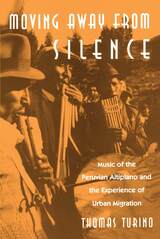 Moving Away from Silence: Music of the Peruvian Altiplano and the Experience of Urban Migration
Thomas Turino
University of Chicago Press, 1993 Increasingly popular in the United States and Europe, Andean panpipe and flute music draws its vitality from the traditions of rural highland villages and of rural migrants who have settled in Andean cities. In Moving Away from Silence, Thomas Turino describes panpipe and flute traditions in the context of this rural-urban migration and the turbulent politics that have influenced Peruvian society and local identities throughout this century.
Turino's ethnography is the first large-scale study to concentrate on the pervasive effects of migration on Andean people and their music. Turino uses the musical traditions of Conima, Peru as a unifying thread, tracing them through the varying lives of Conimeos in different locales. He reveals how music both sustains and creates meaning for a people struggling amid the dramatic social upheavals of contemporary Peru.
Moving Away from Silence contains detailed interpretations based on comparative field research of Conimeo musical performance, rehearsals, composition, and festivals in the highlands and Lima. The volume will be of great importance to students of Latin American music and culture as well as ethnomusicological and ethnographic theory and method.
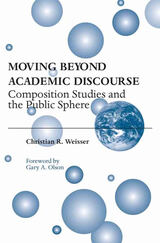 Moving Beyond Academic Discourse: Composition Studies and the Public Sphere
Christian R. Weisser. Foreword by Gary A. Olson
Southern Illinois University Press, 2002 Moving student writing beyond academic discourse and into larger public spheres is a difficult task, but Christian R. Weisser’s study challenges composition instructors to do just that. This highly accessible book does what no other study has attempted to do: place the most current, cutting-edge theories and pedagogies in rhetoric and composition in their intellectual and historical contexts, while at the same time offering a unique, practical theory and pedagogy of public writing for use both inside and outside of the classroom. By positing a theory of the public for composition studies, one which envisions the public sphere as a highly contested, historically textured, multilayered, and sometimes contradictory site, Weisser offers a new approach to the roles that compositionists might assume in their attempts to initiate progressive political and social change. After first providing a historical context that situates composition’s recent interest in public writing, Weisser next examines recent theories in composition studies that consider writing an act of social engagement before outlining a more complex theory of the public based on the work of Jürgen Habermas. The resulting re-envisioning of the public sphere expands current conversations in rhetoric and composition concerning the public. Weisser concludes with a holistic vision that places greater political and social import on addressing public issues and conversations in the composition classroom and that elucidates the role of the public intellectual as it relates specifically to compositionists in postmodern society.
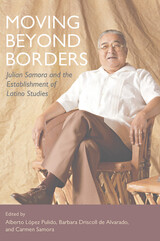 Moving Beyond Borders: Julian Samora and the Establishment of Latino Studies
Edited by Alberto Lopez Pulido, Barbara Driscoll de Alvarado, and Carmen Samora
University of Illinois Press, 2008 Moving Beyond Borders examines the life and accomplishments of Julian Samora, the first Mexican American sociologist in the United States and the founding father of the discipline of Latino studies. Detailing his distinguished career at the University of Notre Dame from 1959 to 1984, the book documents the history of the Mexican American Graduate Studies program that Samora established at Notre Dame and traces his influence on the evolution of border studies, Chicano studies, and Mexican American studies. Samora's groundbreaking ideas opened the way for Latinos to understand and study themselves intellectually and politically, to analyze the complex relationships between Mexicans and Mexican Americans, to study Mexican immigration, and to ready the United States for the reality of Latinos as the fastest growing minority in the nation. In addition to his scholarly and pedagogical impact, his leadership in the struggle for civil rights was a testament to the power of community action and perseverance. Focusing on Samora's teaching, mentoring, research, and institution-building strategies, Moving Beyond Borders explores the legacies, challenges, and future of ethnic studies in United States higher education. Contributors are Teresita E. Aguilar, Jorge A. Bustamante, Gilberto Cárdenas, Miguel A. Carranza, Frank M. Castillo, Anthony J. Cortese, Lydia Espinosa Crafton, Barbara Driscoll de Alvarado, Herman Gallegos, Phillip Gallegos, José R. Hinojosa, Delfina Landeros, Paul López, Sergio X. Madrigal, Ken Martínez, Vilma Martínez, Alberto Mata, Amelia M. Muñoz, Richard A. Navarro, Jesus "Chuy" Negrete, Alberto López Pulido, Julie Leininger Pycior, Olga Villa Parra, Ricardo Parra, Victor Rios, Marcos Ronquillo, Rene Rosenbaum, Carmen Samora, Rudy Sandoval, Alfredo Rodriguez Santos, and Ciro Sepulveda.
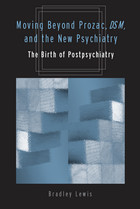 Moving Beyond Prozac, DSM, and the New Psychiatry: The Birth of Postpsychiatry
Bradley Lewis
University of Michigan Press, 2006 "Interesting and fresh-represents an important and vigorous challenge to a discipline that at the moment is stuck in its own devices and needs a radical critique to begin to move ahead."
--Paul McHugh, Johns Hopkins University School of Medicine
"Remarkable in its breadth-an interesting and valuable contribution to the burgeoning literature of the philosophy of psychiatry."
--Christian Perring, Dowling College
Moving Beyond Prozac, DSM, and the New Psychiatry looks at contemporary psychiatric practice from a variety of critical perspectives ranging from Michel Foucault to Donna Haraway. This contribution to the burgeoning field of medical humanities contends that psychiatry's move away from a theory-based model (one favoring psychoanalysis and other talk therapies) to a more scientific model (based on new breakthroughs in neuroscience and pharmacology) has been detrimental to both the profession and its clients. This shift toward a science-based model includes the codification of the Diagnostic and Statistical Manual of Mental Disorders to the status of standard scientific reference, enabling mental-health practitioners to assign a tidy classification for any mental disturbance or deviation. Psychiatrist and cultural studies scholar Bradley Lewis argues for "postpsychiatry," a new psychiatric practice informed by the insights of poststructuralist theory.
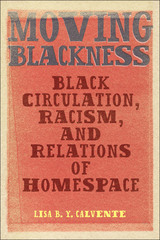 Moving Blackness: Black Circulation, Racism, and Relations of Homespace
Lisa B. Y. Calvente
Rutgers University Press, 2025 Moving Blackness: Black Circulation, Racism, and Relations of Homespace delves into the intricate connections between communication, culture, power, and racism in relation to blackness. Through a blend of interviews, oral histories, and meticulous archival research, this book sheds light on the multifaceted narratives surrounding Black identity. It explores how these stories circulate, serving as tools of resistance, negotiation, and affirmation of diverse manifestations and representations of blackness. By emphasizing the significance of storytelling as a means through which blackness affirms itself, transcending time and space, the book underscores how communicative embodiments of Black identity enable individuals to persevere within marginalized contexts.
Engaging with theories of anti-Black racism, modernity, coloniality, and the Black diaspora, the book frames storytelling and the circulation of narratives as performances deeply rooted in the everyday lives of Black people across the diaspora. Starting with an examination of the racial construction of movement during colonialism and slavery, the book traces how this history shapes contemporary interactions. With its exploration of how Black circulation transforms movement and space, the book introduces a forward-thinking approach to the Black diaspora, anchored in a politics of identification rather than being confined to the past or a specific location. Moving Blackness argues that the desire for homespace, a yearning for belonging that transcends any particular physical space, fuels this envisioned future, rooted in the historical and material conditions of racism and marginalization.
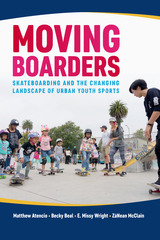 Moving Boarders: Skateboarding and the Changing Landscape of Urban Youth Sports
Matthew Atencio
University of Arkansas Press, 2018 Once considered a kind of delinquent activity, skateboarding is on track to join soccer, baseball, and basketball as an approved way for American children to pass the after-school hours. With family skateboarding in the San Francisco Bay Area as its focus, Moving Boarders explores this switch in stance, integrating first-person interviews and direct observations to provide a rich portrait of youth skateboarders, their parents, and the social and market forces that drive them toward the skate park.
This excellent treatise on the contemporary youth sports scene examines how modern families embrace skateboarding and the role commerce plays in this unexpected new parent culture, and highlights how private corporations, community leaders, parks and recreation departments, and nonprofits like the Tony Hawk Foundation have united to energize skate parks—like soccer fields before them—as platforms for community engagement and the creation of social and economic capital.
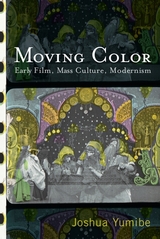 Moving Color: Early Film, Mass Culture, Modernism
Yumibe, Joshua
Rutgers University Press, 2012 Color was used in film well before The Wizard of Oz. Thomas Edison, for example, projected two-colored films at his first public screening in New York City on April 23, 1896. These first colors of early cinema were not photographic; they were applied manually through a variety of laborious processes—most commonly by the hand-coloring and stenciling of prints frame by frame, and the tinting and toning of films in vats of chemical dyes. The results were remarkably beautiful. Moving Color is the first book-length study of the beginnings of color cinema. Looking backward, Joshua Yumibe traces the legacy of color history from the beginning of the nineteenth century to the cinema of the early twentieth century. Looking forward, he explores the implications of this genealogy on experimental and contemporary digital cinemas in which many colors have become, once again, vividly unhinged from photographic reality. Throughout this history, Moving Color revolves around questions pertaining to the sensuousness of color: how color moves us in the cinema—visually, emotionally, and physically.
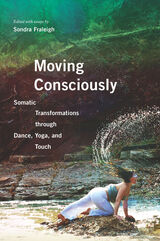 Moving Consciously: Somatic Transformations through Dance, Yoga, and Touch
Edited by Sondra Fraleigh
University of Illinois Press, 2015 The popularity of yoga and Zen meditation has heightened awareness of somatic practices. Individuals develop the conscious embodiment central to somatics work via movement and dance, or through touch from a skilled teacher or therapist often called a somatic bodyworker. Methods of touch and movement foster generative processes of consciousness in order to create a fluid interconnection between sensation, thought, movement, and expression. In Moving Consciously , Sondra Fraleigh gathers essays that probe ideas surrounding embodied knowledge and the conscious embodiment of movement and dance. Using a variety of perspectives on movement and dance somatics, Fraleigh and other contributors draw on scholarship and personal practice to participate in a multifaceted investigation of a thriving worldwide phenomenon. Their goal: to present the mental and physical health benefits of experiencing one's inner world through sensory awareness and movement integration. A stimulating addition to a burgeoning field, Moving Consciously incorporates concepts from East and West into a timely look at life-changing, intertwined practices that involve dance, movement, performance studies, and education. Contributors: Richard Biehl, Robert Bingham, Hillel Braude, Alison East, Sondra Fraleigh, Kelly Ferris Lester, Karin Rugman, Catherine Schaeffer, Jeanne Schul, and Ruth Way.
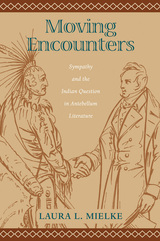 Moving Encounters: Sympathy and the Indian Question in Antebellum Literature
Laura L. Mielke
University of Massachusetts Press, 2008 An old Indian woman comforts two young white children she finds lost in the woods and lovingly carries them back to their eager parents. A frontiersman sheds tears over the grave of a Mohican youth, holding hands with the mourning father. According to Laura L. Mielke, such emotionally charged scenes between whites and Indians paradoxically flourished in American literature from 1820 to 1850, a time when the United States government developed and applied a policy of Indian removal. Although these "moving encounters," as Mielke terms them, often promoted the possibility of mutual sympathy between Native Americans and Euro-Americans, they also suggested that these emotional links were inherently unstable, potentially dangerous, and ultimately doomed. At the same time, the emphasis on Indian-white sympathy provided an opportunity for Indians and non-Native activists to voice an alternative to removal and acculturation, turning the language of a sentimental U.S. culture against its own imperial impulse. Mielke details not only how such writers as James Fenimore Cooper and Henry Rowe Schoolcraft forecast the inevitable demise of Indian-white sympathy, but also how authors like Lydia Maria Child and William Apess insisted that a language of feeling could be used to create shared community or defend American Indian sovereignty. In this way, Moving Encounters sheds new light on a wide range of texts concerning the "Indian Question" by emphasizing their engagement with popular sentimental forms and by challenging the commonly held belief that all Euro-American expressions of sympathy for American Indians in this period were fundamentally insincere. While portraits of Indian-white sympathy often prompted cynical rejoinders from parodists, many never lost faith in the power of emotion to overcome the greed and prejudice fueling the dispossession of American Indians.
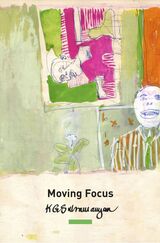 Moving Focus: Essays on Indian Art
K. G. Subramanyan
Seagull Books, 2024 Reflections on the chords and discords inherent in the relationship between tradition and modernism.
Written between the early 1960s and the mid-1970s, the articles and lectures collected in Moving Focus reflect on some of the major concerns of the practicing artist and scholar of modern Indian art: tradition and modernism, the question of the image, and the use of art criticism. The collection also includes essays on the work of Rabindranath Tagore, Abanindranath Tagore, Binodebehari Mukherjee, Ramkinker Baij, and Amrita Sher-Gil. Together, they deal with the focal changes taking place in the contemporary art situation—a period of great significance in terms of cultural development, just about a decade and a half after India’s hard-won Independence—and seek to put them in perspective. The analytical essays of K. G. Subramanyan, one of India's most celebrated artists, remain as relevant and useful today as they were when this collection first appeared decades ago, and are perfectly suited to introducing the non-specialist to Indian modernism and its global concerns.
Subramanyan played a pivotal role in shaping India’s artistic identity after Independence. Mani-da, as he was fondly called, seamlessly blended elements of modernism with folk expression in his works, spanning paintings, murals, sculptures, prints, set designs, and toys. Beyond his visual artistry, his writings have laid a solid foundation for understanding the demands of art on the individual. In the year of his centenary, Seagull is proud to publish his writings in special new editions.
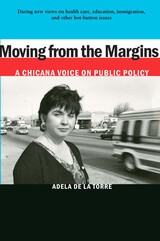 Moving from the Margins: A Chicana Voice on Public Policy
Adela de la Torre
University of Arizona Press, 2002 Immigration reform. Bilingual education. Affirmative action. Such issues trigger knee-jerk reactions from many people, and in California those reactions are likely to fall along strict ethnic lines. A white majority has long called the shots in voter initiatives, but with Mexican Americans becoming the majority population in southern California, their views on these matters can no longer be ignored. In Moving from the Margins, an outspoken member of the Mexican American community explores issues that have molded politics over the past decade in a state where division seems more common than unity.
Addressing immigration, education, health care, and economic and political concerns, Adela de la Torre provides a distinctly Chicana perspective that often differs from that of mainstream readers and voters. Drawn from the author's syndicated column in the Los Angeles Times along with writings from other publications, Moving from the Margins includes incisive and often provocative commentaries that provide insights into the roots of ethnic tensions in the Golden State.
The book also includes readers' reactions to the articles, creating a dialogue of ideas while confronting fears of what many Americans view as an alien culture. Whether addressing entitlements granted to noncitizens, the future of public schools, or access to health care, de la Torre challenges readers to move beyond their own frame of reference and consider new points of view. The issues she faces have shaped today's California—and they also lie at the heart of urban public policy in America for the twenty-first century.
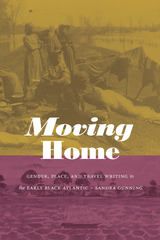 Moving Home: Gender, Place, and Travel Writing in the Early Black Atlantic
Sandra Gunning
Duke University Press, 2021 In Moving Home, Sandra Gunning examines nineteenth-century African diasporic travel writing to expand and complicate understandings of the Black Atlantic. Gunning draws on the writing of missionaries, abolitionists, entrepreneurs, and explorers whose work challenges the assumptions that travel writing is primarily associated with leisure or scientific research. For instance, Yoruba ex-slave turned Anglican bishop Samuel Ajayi Crowther played a role in the Christianization of colonial Nigeria. Sarah Forbes Bonetta, a formerly enslaved girl "gifted" to Queen Victoria, traveled the African colonies as the wife of a prominent colonial figure and under the protection of her benefactress. Alongside Nancy Gardiner Prince, Martin R. Delany, Robert Campbell, and others, these writers used their mobility as African diasporic and colonial subjects to explore the Atlantic world and beyond while they negotiated the complex intersections between nation and empire. Rather than categorizing them as merely precursors of Pan-Africanist traditions, Gunning traces their successes and frustrations to capture a sense of the historical and geographical specificities that shaped their careers.
Moving Image and Sound Collections for Archivists
Anthony Cocciolo
Society of American Archivists, 2017 Moving Image and Sound Collections for Archivists by Anthony Cocciolo is for every archivist (or archivist in training) who has unearthed some carrier of moving image and sound and wondered what to do. Combining best practices with guidance for specific media formats, Cocciolo applies concepts of appraisal, description, and accessioning to audiovisual collections, providing a solid grounding for archivists in environments where resources for description, digitization, and storage are scarce.
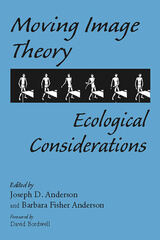 Moving Image Theory: Ecological Considerations
Edited by Joseph D. Anderson and Barbara Fisher Anderson. Foreword by David Bordwell
Southern Illinois University Press, 2007 Blending unconventional film theory with nontraditional psychology to provide a radically different set of critical methods and propositions about cinema, Moving Image Theory: Ecological Considerations looks at film through its communication properties rather than its social or political implications. Drawing on the tenets of James J. Gibson’s ecological theory of visual perception, the fifteen essays and forty-one illustrations gathered here by editors Joseph D. Anderson and Barbara Fisher Anderson offer a new understanding of how moving images are seen and understood.
Focusing on a more straightforward perception of the world and cinema in an attempt to move film theory closer to reality, Moving Image Theory proposes that we should first understand how cinema communicates information about the representation of the three-dimensional world through properties of image and sound.
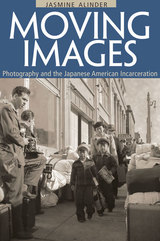 Moving Images: Photography and the Japanese American Incarceration
Jasmine Alinder
University of Illinois Press, 2011 When the American government began impounding Japanese American citizens after Pearl Harbor, photography became a battleground. The control of the means of representation affected nearly every aspect of the incarceration, from the mug shots criminalizing Japanese Americans to the prohibition of cameras in the hands of inmates. The government hired photographers to make an extensive record of the forced removal and incarceration but forbade Japanese Americans from photographically documenting the conditions of the camps or any aspect of their lives. In this insightful study, Jasmine Alinder explores the photographic record of the imprisonment in war relocation centers such as Manzanar, Tule Lake, Jerome, and others. She investigates why photographs were made, how they were meant to function, and how they have been reproduced and interpreted subsequently by the popular press and museums in constructing versions of public history. Considering such factors as artistic intention, institutional deployment, critical interpretation, and popular reception, Alinder provides calibrated readings of the photographs from this period. She uncovers the tension between Dorothea Lange's moving and critical images of the camps and the War Relocation Authority's blindly positive captions. She also analyzes Ansel Adams's attempt to combat negative war propaganda through humanizing photographs of Japanese Americans and locates the limits of such a counternarrative in the midst of a national mobilization against Japan. Moving Images examines the work of Japanese American photographers operating both during and after the incarceration, including Manzanar inmate Toyo Miyatake, who constructed his own camera to document the complicated realities of camp life for his fellow inmates. More recently, contemporary artists Patrick Nagatani and Masumi Hayashi have used photography to reckon with the legacy of incarceration by journeying to the camp sites and creating photographs that bridge the intergenerational divides between their parents, themselves, and their children. Illustrated with more than forty photographs, Moving Images reveals the significance of the camera in the process of incarceration as well as the construction of race, citizenship, and patriotism in this complex historical moment.
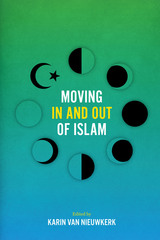 Moving In and Out of Islam
By Karin van Nieuwkerk
University of Texas Press, 2018 Embracing a new religion, or leaving one’s faith, usually constitutes a significant milestone in a person’s life. While a number of scholars have examined the reasons why people convert to Islam, few have investigated why people leave the faith and what the consequences are for doing so. Taking a holistic approach to conversion and deconversion, Moving In and Out of Islam explores the experiences of people who have come into the faith along with those who have chosen to leave it—including some individuals who have both moved into and out of Islam over the course of their lives. Sixteen empirical case studies trace the processes of moving in or out of Islam in Western and Central Europe, the United States, Canada, and the Middle East. Going beyond fixed notions of conversion or apostasy, the contributors focus on the ambiguity, doubts, and nonlinear trajectories of both moving in and out of Islam. They show how people shifting in either direction have to learn or unlearn habits and change their styles of clothing, dietary restrictions, and ways of interacting with their communities. They also look at how communities react to both converts to the religion and converts out of it, including controversies over the death penalty for apostates. The contributors cover the political aspects of conversion as well, including debates on radicalization in the era of the “war on terror” and the role of moderate Islam in conversions.
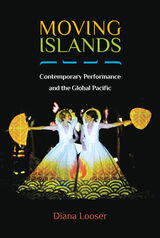 Moving Islands: Contemporary Performance and the Global Pacific
Diana Looser
University of Michigan Press, 2021 Moving Islands reveals the international and intercultural connections within contemporary performance from Oceania, focusing on theater, performance art, art installations, dance, film, and activist performance in sites throughout Oceania and in Australia, Asia, North America, and Europe. Diana Looser’s study moves beyond a predictable country-specific or island-specific focus to encompass an entire region defined by diversity and global exchange, showing how performance operates to frame social, artistic, and political relationships across widely dispersed locations. The study also demonstrates how Oceanian performance contributes to international debates about diaspora, indigeneity, urbanization, and environmental sustainability. The author considers the region’s unique cultural and geographic dynamics as she brings forth the paradigm of transpasifika to suggest a way of understanding these intercultural exchanges and connections, with the aim to “rework the cartographic and disciplinary priorities of transpacific studies to privilege the activities of Islander peoples.”
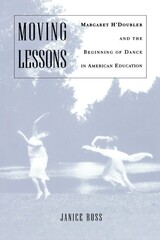 Moving Lessons: Margaret H'Doubler and the Beginning of Dance in American Education
Janice Ross
University of Wisconsin Press, 2000 Moving Lessons is an insightful and sophisticated look at the origins and influence of dance in American universities, focusing on Margaret H'Doubler, who established the first university courses and the first degree program in dance (at the University of Wisconsin). Dance educator and historian Janice Ross shows that H'Doubler (1889–1982) was both emblematic of her time and an innovator who made deep imprints in American culture. An authentic "New Woman," H'Doubler emerged from a sheltered female Victorian world to take action in the public sphere. She changed the way Americans thought, not just about female physicality but also about higher education for women.
Ross brings together many discourses—from dance history, pedagogical theory, women's history, feminist theory, American history, and the history of the body—in intelligent, exciting, and illuminating ways and adds a new chapter to each of them. She shows how H'Doubler, like Isadora Duncan and other modern dancers, helped to raise dance in the eyes of the middle class from its despised status as lower-class entertainment and "dangerous" social interaction to a serious enterprise. Taking a nuanced critical approach to the history of women's bodies and their representations, Moving Lessons fills a very large gap in the history of dance education.
Moving Materials
Valerie American Library Association
American Library Association, 2009
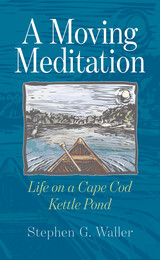 A Moving Meditation: Life on a Cape Cod Kettle Pond
Stephen G. Waller
University of Massachusetts Press, 2023 Cape Cod is known for its beaches, throngs of summer visitors, and the activities that accompany seaside living, but it is also home to many kettle ponds, which offer a more tranquil setting. Formed from glaciers breaking apart and so named due to a rounded shape that appears like a kettle, these waterways are home to a diverse array of wildlife, while remaining peaceful and even a bit hidden. Big enough for a canoeist to feel solitude and serenity, small enough to not appear on large-scale maps, Centerville’s Long Pond (one of seven on the Cape that share this name), consists of fifty-one acres of crystal clear waters, fresh air, and the fish, turtles, waterfowl, ospreys, and otters that call this special place home. In A Moving Meditation, Stephen G. Waller offers an intimate look at the pond’s intriguing natural and human history; its abundant animal life, across the seasons; and the encroaching effects of climate change.
Moving On: The Heroines of Shirley Ann Grau, Anne Tyler, and Gail Godwin
Susan S. Kissel
University of Wisconsin Press, 1996 Focusing on the works of Grau, Tyler, and Godwin, Susan S. Kissel shows how these writers portray their white southern women protagonists as “moving on,” with their heroines not only renouncing southern patriarchal tradition but actually establishing independent lives and caring communities. These authors are beginning to close the gap that has existed between themselves and black Southern women writers, whose protagonists have long shown that the strength and independence of female maturity must be synonymous with complete character development.
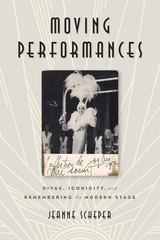 Moving Performances: Divas, Iconicity, and Remembering the Modern Stage
Scheper, Jeanne
Rutgers University Press, 2017 Fabulous yet fierce, imperious yet impetuous, boss yet bitchy—divas are figures of paradox. Their place in culture is equally contradictory, as they are simultaneously venerated and marginalized, hailed as timeless but then frequently forgotten or exhumed as cult icons by future generations. Focusing on four early twentieth-century divas—Aida Overton Walker, Loïe Fuller, Libby Holman, and Josephine Baker—who were icons in their own time, Moving Performances considers what their past and current reception reveals about changing ideas of race and gender. Jeanne Scheper examines how iconicity can actually work to the diva’s detriment, reducing her to a fetish object, a grotesque, or a figure of nostalgia. Yet she also locates more productive modes of reception that reach to revive the diva’s moving performances, imbuing her with an affective afterlife. As it offers innovative theorizations of performance, reception, and affect, Moving Performances also introduces readers to four remarkable women who worked as both cultural producers and critics, deftly subverting the tropes of exoticism, orientalism, and primitivism commonly used to dismiss women of color. Rejecting iconic depictions of these divas as frozen in a past moment, Scheper vividly demonstrates how their performances continue to inspire ongoing movements.
Moving Pictures
Anne Hollander
Harvard University Press Anne Hollander begins with the great masters of the fifteenth and sixteenth centuries—Van Eyck, Durer, Bruegel—and progresses through the history of European art to the advent of film in the modern era. She explores the interconnectedness of painting, prints, and film as modes of art that in comparable ways depict moments in the narrative flow of human life. Moving Pictures offers a new way of assessing the artistic, emotional, and psychological power of paintings and pictures—and of understanding our own deepest responses to them.
Moving Pictures and Renaissance Art History
Patricia Emison
Amsterdam University Press, 2021 Film, like the printed imagery inaugurated during the Renaissance, spread ideas – not least the idea of the power of visual art – across not only geographical and political divides but also strata of class and gender. Moving Pictures and Renaissance Art History examines the early flourishing of film, from the 1920s to the mid-1960s, as partly reprising the introduction of mass media in the Renaissance, allowing for innovation that reflected an art free of the control of a patron though required to attract a broad public. Rivalry between word and image, between the demands of narrative and those of visual composition, spurred new ways of addressing the compelling nature of the visual. The twentieth century also saw the development of the discipline of art history; transfusions between cinematic practice and art historical postulates are part of the story told here.
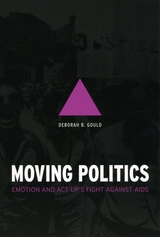 Moving Politics: Emotion and ACT UP's Fight against AIDS
Deborah B. Gould
University of Chicago Press, 2009 In the late 1980s, after a decade spent engaged in more routine interest-group politics, thousands of lesbians and gay men responded to the AIDS crisis by defiantly and dramatically taking to the streets. But by the early 1990s, the organization they founded, ACT UP, was no more—even as the AIDS epidemic raged on. Weaving together interviews with activists, extensive research, and reflections on the author’s time as a member of the organization, Moving Politics is the first book to chronicle the rise and fall of ACT UP, highlighting a key factor in its trajectory: emotion. Surprisingly overlooked by many scholars of social movements, emotion, Gould argues, plays a fundamental role in political activism. From anger to hope, pride to shame, and solidarity to despair, feelings played a significant part in ACT UP’s provocative style of protest, which included raucous demonstrations, die-ins, and other kinds of street theater. Detailing the movement’s public triumphs and private setbacks, Moving Politics is the definitive account of ACT UP’s origin, development, and decline as well as a searching look at the role of emotion in contentious politics.
Moving Stones: About the Art of Edmonia Lewis
Jennifer DeVere Brody
Duke University Press, 2026 Moving Stones explores the extraordinary life and work of Edmonia Lewis, the Black and Ojibwe sculptor who rose to international fame in the nineteenth century. Blending biography, history, and theory, Jennifer DeVere Brody approaches Lewis’s legacy through a Black feminist and queer lens, illuminating how her sculptures and self-fashioning challenged constraints of her time. Living much of her life in Rome as a free Afro-Native woman, Lewis used neoclassical forms to carve out a life in art. Brody considers how Lewis’s works were viewed historically and how they resonate with postmodern artists, engaging themes of race, materiality, sexuality, and embodiment. Rethinking one of the most important sculptors of her era, Moving Stones shows how Lewis’s art continues to inspire contemporary artists and scholars today.
 Moving the Masses: Urban Public Transit in New York
Charles W. Cheape
Harvard University Press, 1980 The development of public transit is an integral part of both business and urban history in late nineteenth-century America. The author begins this study in 1880, when public transportation in large American cities was provided by numerous, competing horse-car companies with little or no public control of operation. By 1912, when the study concludes, a monopoly in each city operated a coordinated network of electric-powered streetcars and, in the largest cities, subways, which were regulated by city and state agencies. The history of transit development reflects two dominant themes: the constant pressure of rapid growth in city population and area and the requirements of the technology developed to service that growth.
The case studies here include three of the four cites that had rapid transit during this period. Each case study examines, first, the mechanization of surface lines and, second, the implementation of rapid transit. New York requires an additional chapter on steam-powered, elevated railroads, for early population growth there required rapid transit before the invention of electric technology. Urban transit enterprise is viewed within a clear and familiar pattern of evolution—the pattern of the last half of the nineteenth century, when industries with expanding markets and complex, costly processes of production and distribution adopted new strategy and structure, administered by a new class of professional managers.
Moving the Mountain: The Women's Movement in America since 1960
Flora Davis
University of Illinois Press, 1999 Moving the Mountain tells the story of the struggles and triumphs of thousands of activists who achieved "half a revolution" between 1960 and 1990. In this award-winning book, the most complete history of the women's movement to date, Flora Davis presents a grass-roots view of the small steps and giant leaps that have changed laws and institutions as well as the prejudices and unspoken rules governing a woman's place in American society. Looking at every major feminist issue from the point of view of the participants in the struggle, Moving the Mountain conveys the excitement, the frustration, and the creative chaos of feminism's Second Wave. A new afterword assesses the movement's progress in the 1990s and prospects for the new century.
 Moving to Market: Restructuring Transport in the Former Soviet Union
John Strong
Harvard University Press, 1996 Transport in the former Soviet Union is experiencing massive changes in the 1990s: government responsibility has changed from operation to oversight; competition in the industry is increasing; and alternative financing and investment methods are emerging. Moving to Market examines rail, road, water, and air transport in the former Soviet Union and discusses the policy issues involved in making a transition from an industry once entrenched in a centrally planned economy to an industry that can thrive in a more open market. The authors conclude that the raw physical capacity is in place, but that quality of service and product needs to be improved. In addition, price structures need to be changed to reflect real costs and market demands.
The authors cite the "three M's"--marshaling, managing, and monitoring transport resources--as critical for the development of the nation's infrastructure as it moves toward the next century.
 Moving toward Integration: The Past and Future of Fair Housing
Richard H. Sander, Yana A. Kucheva, and Jonathan M. Zasloff
Harvard University Press, 2018 Reducing residential segregation is the best way to reduce racial inequality in the United States. African American employment rates, earnings, test scores, even longevity all improve sharply as residential integration increases. Yet far too many participants in our policy and political conversations have come to believe that the battle to integrate America’s cities cannot be won. Richard Sander, Yana Kucheva, and Jonathan Zasloff write that the pessimism surrounding desegregation in housing arises from an inadequate understanding of how segregation has evolved and how policy interventions have already set many metropolitan areas on the path to integration.
Scholars have debated for decades whether America’s fair housing laws are effective. Moving toward Integration provides the most definitive account to date of how those laws were shaped and implemented and why they had a much larger impact in some parts of the country than others. It uses fresh evidence and better analytic tools to show when factors like exclusionary zoning and income differences between blacks and whites pose substantial obstacles to broad integration, and when they do not.
Through its interdisciplinary approach and use of rich new data sources, Moving toward Integration offers the first comprehensive analysis of American housing segregation. It explains why racial segregation has been resilient even in an increasingly diverse and tolerant society, and it demonstrates how public policy can align with demographic trends to achieve broad housing integration within a generation.
Moving Up and Getting On: Migration, Integration and Social Cohesion in the UK
Jill Rutter
Bristol University Press, 2015 The question of immigration is a perennial hot topic in politics around the world. What gets far less attention is what happens to immigrants after their arrival—how they integrate into their newly chosen societies. This book draws on fieldwork in London and eastern England, analyzing and critiquing the effectiveness of recent policies that aim to promote integration and social cohesion. Successful management of immigration, Jill Rutter argues, requires a greater emphasis on the social aspects of integration and opportunities for meaningful social interactions between migrants and long-settled residents, particularly in workplaces.
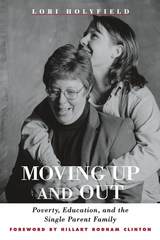 Moving Up And Out: Poverty, Education & Single Parent Family
Lori Holyfield, foreword by Hillary Rodham Clinton
Temple University Press, 2001 Single parent families in the United States have almost tripled in the past few decades. A huge majority of these families are female headed. In American culture it is not so important that we all be equal so much as it is that we all have equal opportunities. Yet sometimes we turn a blind eye to those who need us most. In fact, when it comes to single parent families, it is as if the barriers are too great, the issues too complex. We wind up reducing the debate to its lowest common denominator. Ironically, it is the families who are most affected that get tangled in the political barbed wire and hidden behind numbing statistics. Moreover, community responses, those small grassroots organizations who care deeply and give whole-heartedly are seldom celebrated, seldom recognized for their empowering efforts. Moving Up and Out focuses on just such a program, the Arkansas Single Parent Scholarship Fund, which has since 1984 provided scholarships for single parents interested in obtaining their post-secondary education. In this story of a highly successful nonprofit, Lori Holyfield (herself a recipient of a scholarship) draws upon the voices of single parents to consider the barriers and struggles faced as they attempt to obtain secondary education and change the lives of both themselves and their children. The help this program has brought to Arkansas residents is needed throughout the country.
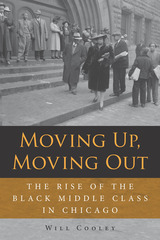 Moving Up, Moving Out: The Rise of the Black Middle Class in Chicago
Will Cooley
Northern Illinois University Press, 2018 In Moving Up, Moving Out, Will Cooley discusses the damage racism and discrimination have exacted on black Chicagoans in the twentieth century, while accentuating the resilience of upwardly-mobile African Americans. Cooley examines how class differences created fissures in the black community and produced quandaries for black Chicagoans interested in racial welfare.
While black Chicagoans engaged in collective struggles, they also used individualistic means to secure the American Dream. Black Chicagoans demonstrated their talent and ambitions, but they entered through the narrow gate, and whites denied them equal opportunities in the educational institutions, workplaces, and neighborhoods that produced the middle class. African Americans resisted these restrictions at nearly every turn by moving up into better careers and moving out into higher-quality neighborhoods, but their continued marginalization helped create a deeply dysfunctional city.
African Americans settled in Chicago for decades, inspired by the gains their forerunners were making in the city. Though faith in Chicago as a land of promise wavered, the progress of the black middle class kept the city from completely falling apart. In this important study, Cooley shows how Chicago, in all of its glory and faults, was held together by black dreams of advancement. Moving Up, Moving Out will appeal to urban historians and sociologists, scholars of African American studies, and general readers interested in Chicago and urban history.
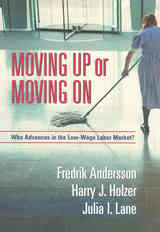 Moving Up or Moving On: Who Gets Ahead in the Low-Wage Labor Market?
Fredrik Andersson
Russell Sage Foundation, 2005 For over a decade, policy makers have emphasized work as the best means to escape poverty. However, millions of working Americans still fall below the poverty line. Though many of these "working poor" remain mired in poverty for long periods, some eventually climb their way up the earnings ladder. These success stories show that the low wage labor market is not necessarily a dead end, but little research to date has focused on how these upwardly mobile workers get ahead. In Moving Up or Moving On, Fredrik Andersson, Harry Holzer, and Julia Lane examine the characteristics of both employees and employers that lead to positive outcomes for workers. Using new Census data, Moving Up or Moving On follows a group of low earners over a nine-year period to analyze the behaviors and characteristics of individuals and employers that lead workers to successful career outcomes. The authors find that, in general, workers who "moved on" to different employers fared better than those who tried to "move up" within the same firm. While changing employers meant losing valuable job tenure and spending more time out of work than those who stayed put, workers who left their jobs in search of better opportunity elsewhere ended up with significantly higher earnings in the long term—in large part because they were able to find employers that paid better wages and offered more possibilities for promotion. Yet moving on to better jobs is difficult for many of the working poor because they lack access to good-paying firms. Andersson, Holzer, and Lane demonstrate that low-wage workers tend to live far from good paying employers, making an improved transportation infrastructure a vital component of any public policy to improve job prospects for the poor. Labor market intermediaries can also help improve access to good employers. The authors find that one such intermediary, temporary help agencies, improved long-term outcomes for low-wage earners by giving them exposure to better-paying firms and therefore the opportunity to obtain better jobs. Taken together, these findings suggest that public policy can best serve the working poor by expanding their access to good employers, assisting them with job training and placement, and helping them to prepare for careers that combine both mobility and job retention strategies. Moving Up or Moving On offers a compelling argument about how low-wage workers can achieve upward mobility, and how public policy can facilitate the process. Clearly written and based on an abundance of new data, this book provides concrete, practical answers to the large questions surrounding the low-wage labor market.
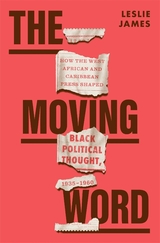 The Moving Word: How the West African and Caribbean Press Shaped Black Political Thought, 1935–1960
Leslie James
Harvard University Press, 2025 A revelatory account of Black Atlantic political thought in the era of decolonization, revealing how West African and Caribbean newspapers invigorated debates about imperialism, capitalism, and Black freedom.
In the 1930s and 1940s, amid intensifying anticolonial activism across the British Empire, dozens of new West African and Caribbean newspapers printed their first issues. With small staffs and shoestring budgets, these newspapers nonetheless became powerful vehicles for the expression of Black political thought. Drawing on papers from Trinidad, Jamaica, Ghana, and Nigeria, Leslie James shows how the press on both sides of the Atlantic nourished anticolonial and antiracist movements. Editors with varying levels of education, men and women journalists, worker and peasant correspondents, and anonymous contributors voiced incisive critiques of empire and experimented with visions of Black freedom. But as independence loomed, the press transformed to better demonstrate the respectability expected of a self-governing people.
Seeing themselves as “the Fourth and Only Estate,” the sole democratic institution available to a colonized population, early press contributors experimented with the form and function of the newspaper itself. They advanced anticolonial goals through clipping and reprinting articles from a variety of sources; drawing on local ways of speaking; and manipulating photography, comics, and advertising. Such unruly content, James shows, served as a strategic assertion of autonomy against colonial bureaucracy. Yet in the 1950s, this landscape changed as press professionalism became a proxy for a colony’s capacity to govern itself. Influenced by new political paradigms, papers either standardized their formats or stopped publishing altogether. By the 1960s, intellectual debates about racism and colonialism had moved to other kinds of publications.
Illuminating an extraordinary period in the history of Black Atlantic political thought, The Moving Word vividly portrays the power of experimental media.
The Moxon Tennyson: A Landmark in Victorian Illustration
Simon Cooke
Ohio University Press, 2021 A new perspective on a book that transformed Victorian illustration into a stand-alone art. Edward Moxon’s 1857 edition of Alfred, Lord Tennyson’s Poems dramatically redefined the relationship between images and words in print. Cooke’s study, the first book to address the subject in over 120 years, presents a sweeping analysis of the illustrators and the complex and challenging ways in which they interpreted Tennyson’s poetry. This book considers the volume’s historical context, examining in detail the roles of publisher, engravers, and binding designer, as well as the material difficulties of printing its fine illustrations, which recreate the effects of painting. Arranged thematically and reproducing all the original images, the chapters present a detailed reappraisal of the original volume and the distinctive culture that produced it.
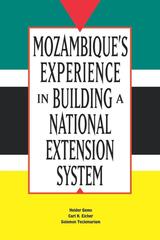 Mozambique's Experience in Building a National Extension System
Helder Gemo
Michigan State University Press, 2005 Agricultural extension services are undergoing rapid change in many countries, with a shift in funding and management from the public to the private sector. This is especially true in Africa, where donors from industrial countries, and more recently from the middle-income developing countries such as Chile, have historically promoted and financed those extension models. Currently, African nations are being encouraged to import the Farmer Field School extension model, which is meeting with some success in Asia.
Mozambique, a former Portuguese colony, became independent in 1975 but was wracked by civil war in the 1980s. It was unable to establish its public extension service until 1987. The authors analyze the growth and evolution of extension from 1987 to 2004, as provided by public, private, and NGO sources in Mozambique.
This work highlights the Ministry of Agriculture's drive to develop and test both local and imported extension models and share its experience with other African countries.
Mozambique’s Samora Machel: A Life Cut Short
Allen F. Isaacman
Ohio University Press, 2020 The precipitous rise and controversial fall of a formidable African leader. Samora Machel (1933–1986), the son of small-town farmers, led his people through a war against their Portuguese colonists and became the first president of the People’s Republic of Mozambique. Machel’s military successes against a colonial regime backed by South Africa, Rhodesia, the United States, and its NATO allies enhanced his reputation as a revolutionary hero to the oppressed people of Southern Africa. In 1986, during the country’s civil war, Machel died in a plane crash under circumstances that remain uncertain. Allen and Barbara Isaacman lived through many of these changes in Mozambique and bring personal recollections together with archival research and interviews with others who knew Machel or participated in events of the revolutionary or post-revolutionary years.
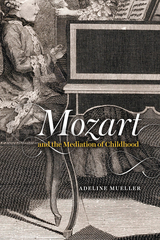 Mozart and the Mediation of Childhood
Adeline Mueller
University of Chicago Press, 2021 The story of Wolfgang Amadeus Mozart’s precocity is so familiar as to be taken for granted. In scholarship and popular culture, Mozart the Wunderkind is often seen as belonging to a category of childhood all by himself. But treating the young composer as an anomaly risks minimizing his impact. In this book, Adeline Mueller examines how Mozart shaped the social and cultural reevaluation of childhood during the Austrian Enlightenment. Whether in a juvenile sonata printed with his age on the title page, a concerto for a father and daughter, a lullaby, a musical dice game, or a mass for the consecration of an orphanage church, Mozart’s music and persona transformed attitudes toward children’s agency, intellectual capacity, relationships with family and friends, political and economic value, work, school, and leisure time.
Thousands of children across the Habsburg Monarchy were affected by the Salzburg prodigy and the idea he embodied: that childhood itself could be packaged, consumed, deployed, “performed”—in short, mediated—through music. This book builds upon a new understanding of the history of childhood as dynamic and reciprocal, rather than a mere projection or fantasy—as something mediated not just through texts, images, and objects but also through actions. Drawing on a range of evidence, from children’s periodicals to Habsburg court edicts and spurious Mozart prints, Mueller shows that while we need the history of childhood to help us understand Mozart, we also need Mozart to help us understand the history of childhood.
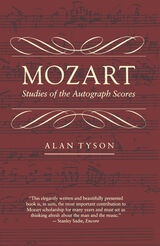 Mozart: Studies of the Autograph Scores
Alan Tyson
Harvard University Press, 1987 The results and implications of Alan Tyson’s work on Mozart have had a profound impact on virtually every aspect of research on this composer: biography, chronology of compositions, working methods, stylistic analysis. Central, perhaps, are Tyson’s discoveries on chronology: time and again he has proved that datings, often of large, well-known works, that have been accepted for generations are not only erroneous but based on little more than speculation. This book assembles his major articles, previously scattered through magazines, journals, and festschrifts, plus two unpublished pieces, into a treasure trove for musicologists and music lovers.
Tyson’s investigations, using primarily paper analysis, span Mozart’s entire career and the full range of genres—string quartets, operas, choral music, keyboard music, concertos, and symphonies. He goes into the genesis of major works such as Cosi fan tutte, the “Prague” Symphony, the Piano Sonata K.333, the “Haydn” quartets, and La clemenza di Tito. His conclusions about chronology bear directly on biographical questions and current accounts of Mozart’s stylistic development as well as his compositional methods. We learn here, for example, that the “first” horn concerto was in fact Mozart’s last, and that he did not even complete the second movement, which was finished after his death by his pupil Süssmayr. The writing (and, in some cases, rewriting) of his later operas such as Figaro and Cosi fan tutte also lends itself to investigation by the same techniques; this is resulting in the rediscovery of some lost measures and little-known variant versions of arias.
Tyson’s style is clear and elegant, and the originality of his work and the soundness of his inferences make this book a pleasure.
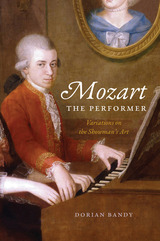 Mozart the Performer: Variations on the Showman's Art
Dorian Bandy
University of Chicago Press, 2023 An innovative study of the ways performance influenced Mozart’s compositional style.
We know Mozart as one of history’s greatest composers. But his contemporaries revered him as a multi-instrumentalist, a dazzling improviser, and the foremost keyboard virtuoso of his time. When he composed, it was often with a single aim in mind: to set the stage, quite literally, for compelling and captivating performances. He wrote piano concertos not with an eye to posterity but to give himself a repertoire with which to flaunt his keyboard wizardry before an awestruck public. The same was true of his sonatas, string quartets, symphonies, and operas, all of which were painstakingly crafted to produce specific effects on those who played or heard them, amusing, stirring, and ravishing colleagues and consumers alike.
Mozart the Performer brings to life this elusive side of Mozart’s musicianship. Dorian Bandy traces the influence of showmanship on Mozart’s style, showing through detailed analysis and imaginative historical investigation how he conceived his works as a series of dramatic scripts. Mozart the Performer is a book for anyone who wishes to engage more deeply with Mozart’s artistry and legacy and understand why, centuries later, his music still captivates us.
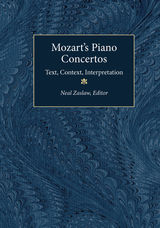 Mozart's Piano Concertos: Text, Context, Interpretation
Neal Zaslaw, Editor
University of Michigan Press, 1997 Like the symphonies of Beethoven, Mozart's piano concertos constitute an extraordinary body of work that will never disappear from our culture. Yet despite widespread recognition of their importance, they still present many interpretive problems. In 1989, the Michigan MozartFest brought expert performers, instrument makers, critics, music theorists, and musicologists together for the first symposium devoted exclusively to Mozart's piano concertos. The twenty-one essays in Mozart's Piano Concertos, culled from that event, richly broaden our understanding of this corpus.
The volume's first section consists of commentaries on the texts of the concertos, including thoughts on creating a critical edition. In subsequent sections, contributors analyze the structure of the pieces and the circumstances in which they were first composed and performed. How do these works compare with other concertos of the period? Where were Mozart's contributions truly original, where conventional? What musical references did he expect his listeners to catch?
Generously illustrated with facsimiles, tables, and more than one-hundred musical examples, Mozart's Piano Concertos substantially advances our understanding of these wonderful works. Its exceptional scope--addressing everything from textual problems (what notes should be played?) to performance practice (how can we make the music sound more nearly as Mozart heard it?)--will make it invaluable to anyone who loves his piano concertos.
Contributors:
V. Kofi Agawu, Wye Jameson Allanbrook, Eva Badura-Skoda, Karol Berger, Richard Crawford, Ellwood Derr, Dexter Edge, Cliff Eisen, Martha Feldman, David Grayson, William Kinderman, Robert D. Levin, Janet M. Levy, David Rosen, Carl Schachter, Elaine Sisman, Jane R. Stevens, Alan Tyson, James Webster, Christoph Wolff, and Neal Zaslaw.
Neal Zaslaw is Professor of Music, Cornell University.
MP vol 110 num 3
The University of Chicago Press
University of Chicago Press Journals, 2013
MP vol 110 num 4
The University of Chicago Press
University of Chicago Press Journals, 2013
MP vol 111 num 1
The University of Chicago Press
University of Chicago Press Journals, 2013
MP vol 111 num 2
The University of Chicago Press
University of Chicago Press Journals, 2013
MP vol 111 num 3
The University of Chicago Press
University of Chicago Press Journals, 2014
MP vol 111 num 4
The University of Chicago Press
University of Chicago Press Journals, 2014
MP vol 112 num 1
The University of Chicago Press
University of Chicago Press Journals, 2014
MP vol 112 num 2
The University of Chicago Press
University of Chicago Press Journals, 2014
MP vol 112 num 3
The University of Chicago Press
University of Chicago Press Journals, 2015
MP vol 112 num 4
The University of Chicago Press
University of Chicago Press Journals, 2015
MP vol 113 num 1
The University of Chicago Press
University of Chicago Press Journals, 2015
MP vol 113 num 2
The University of Chicago Press
University of Chicago Press Journals, 2015
MP vol 113 num 3
The University of Chicago Press
University of Chicago Press Journals, 2016
MP vol 113 num 4
The University of Chicago Press
University of Chicago Press Journals, 2016
MP vol 114 num 1
The University of Chicago Press
University of Chicago Press Journals, 2016
MP vol 114 num 2
The University of Chicago Press
University of Chicago Press Journals, 2016
MP vol 114 num 3
The University of Chicago Press
University of Chicago Press Journals, 2017
MP vol 114 num 4
The University of Chicago Press
University of Chicago Press Journals, 2017
MP vol 115 num 1
The University of Chicago Press
University of Chicago Press Journals, 2017
MP vol 115 num 2
The University of Chicago Press
University of Chicago Press Journals, 2017
MP vol 115 num 3
The University of Chicago Press
University of Chicago Press Journals, 2017
MP vol 115 num 4
The University of Chicago Press
University of Chicago Press Journals, 2018
MP vol 116 num 1
The University of Chicago Press
University of Chicago Press Journals, 2018
MP vol 116 num 2
The University of Chicago Press
University of Chicago Press Journals, 2018
MP vol 116 num 3
The University of Chicago Press
University of Chicago Press Journals, 2019
MP vol 116 num 4
The University of Chicago Press
University of Chicago Press Journals, 2019
MP vol 117 num 1
The University of Chicago Press
University of Chicago Press Journals, 2019 This is volume 117 issue 1 of Modern Philology. Modern Philology (MP) publishes original work in literary criticism, literary history, and archival scholarship. The journal welcomes contributions on literature in all modern world languages and encourages productive comparisons of texts and traditions from any part of the world. It accepts essays that focus on earlier periods as well as the present. MP also aims to publish timely review articles, reviews of recent books, and research on archival documents.
MP vol 117 num 2
The University of Chicago Press
University of Chicago Press Journals, 2019
MP vol 117 num 3
The University of Chicago Press
University of Chicago Press Journals, 2020
MP vol 117 num 4
The University of Chicago Press
University of Chicago Press Journals, 2020
MP vol 118 num 1
The University of Chicago Press
University of Chicago Press Journals, 2020
MP vol 118 num 2
The University of Chicago Press
University of Chicago Press Journals, 2020
MP vol 118 num 3
The University of Chicago Press
University of Chicago Press Journals, 2021
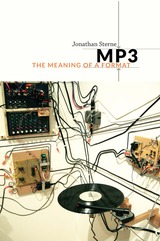 MP3: The Meaning of a Format
Jonathan Sterne
Duke University Press, 2012 MP3: The Meaning of a Format recounts the hundred-year history of the world's most common format for recorded audio. Understanding the historical meaning of the MP3 format entails rethinking the place of digital technologies in the larger universe of twentieth-century communication history, from hearing research conducted by the telephone industry in the 1910s, through the mid-century development of perceptual coding (the technology underlying the MP3), to the format's promiscuous social life since the mid 1990s. MP3s are products of compression, a process that removes sounds unlikely to be heard from recordings. Although media history is often characterized as a progression toward greater definition, fidelity, and truthfulness, MP3: The Meaning of a Format illuminates the crucial role of compression in the development of modern media and sound culture. Taking the history of compression as his point of departure, Jonathan Sterne investigates the relationships among sound, silence, sense, and noise; the commodity status of recorded sound and the economic role of piracy; and the importance of standards in the governance of our emerging media culture. He demonstrates that formats, standards, and infrastructures—and the need for content to fit inside them—are every bit as central to communication as the boxes we call "media."
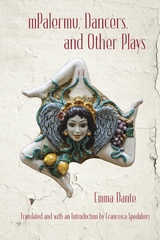 mPalermu, Dancers, and Other Plays
Emma Dante
Swan Isle Press, 2019 Emma Dante’s passionate and brutal plays stem from a need to confront important familial and societal realities in contemporary southern Italy. Her twenty-first century tales challenge stereotypes of the country and stage acts of resistance against the social, political, and economic conditions of Sicily. The seven works in this anthology paint a complex image of the peninsula through stories of disenfranchisement, misogyny, deep-set bigotry, and religious hypocrisy that reveal economic disparities between the north and south of the country, oppressive gender relations, and deep rooted mafioso-like attitudes. Dante’s lyrical and visceral storytelling oscillates between the humorous and the tragic aspects of everyday life, undertaking an irreverent subversion of the status quo with its extreme physicality and unsettling imagery.
This exquisite first English translation of Emma Dante’s work enables English-speaking readers, theatre scholars, and directors alike to encounter character-driven “civic theatre” with its portraits of individuals existing at the fringes of Italy. Ultimately, it allows us to “listen” to those who are not given a voice anywhere else.
 Mr Adamson
Urs Widmer
Seagull Books, 2019 The day is Friday, May 22, 2032. On this day, the day after his ninety-fourth birthday, a man is sitting in a beautiful garden. It is a paradise where he often played during his childhood, and it is here that he is recording the story of his adventures with Mr. Adamson. In the course of this compelling novel from Swiss author Urs Widmer, this man narrates his unusual story to his granddaughter, Anni. While he recounts his life, he is also waiting—waiting for the arrival of this very Mr. Adamson, whom he has not seen since the age of eight. Even then it was a mysterious encounter—a glimpse into realms that normally remain concealed to the living. For Mr. Adamson died at the very moment when our narrator was born, and he will soon return to escort the ninety-four-year-old narrator into another paradise.
Told with Urs Widmer’s signature humor, genius, and lively imagination, Mr Adamson is a superb story and a spellbinding book. With its vitality and zest for life, it manages to hold at bay that scandal we must all face in our lives: death.
Praise for Widmer
“One of the best representatives of Swiss literature.”—Le Monde
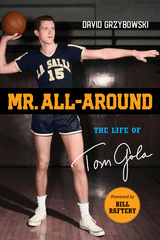 Mr. All-Around: The Life of Tom Gola
David Grzybowski
Temple University Press, 2019 Tom Gola is a Philadelphia Big Five basketball icon. He led La Salle to the NIT championship in 1952 and the NCAA championship in 1954, and holds the NCAA record for most rebounds in a career. Gola also helped the Philadelphia Warriors win the NBA championship as a rookie in 1956 and was named an All-Star five times before retiring in 1966. But Gola also had many amazing achievements as a coach; his La Salle Explorer teams were a large part of the national basketball landscape. He was inducted into the Naismith Memorial Basketball Hall of Fame in 1976.
In Mr. All-Around, avid sports fan and reporter David Grzybowski provides a definitive biography of Gola. He uses exclusive interviews he conducted with Gola in 2013 and features anecdotes by many figures of Philadelphia and basketball history, including John Cheney, Fran Dunphy, and Lionel Simmons.
After the NBA, Gola transitioned to a second career as a politician, serving as Pennsylvania State Representative and Philadelphia City Controller. His dedication to public service involved joining politician Arlen Specter on a campaign that revolutionized political marketing within Philadelphia. Mr. All-Around is an affectionate testament to the life, career, and legacy of one of Philadelphia’s most beloved sports legends.
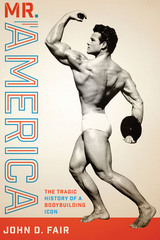 Mr. America: The Tragic History of a Bodybuilding Icon
By John D. Fair
University of Texas Press, 2015 For most of the twentieth century, the “Mr. America” image epitomized muscular manhood. From humble beginnings in 1939 at a small gym in Schenectady, New York, the Mr. America Contest became the world’s premier bodybuilding event over the next thirty years. Rooted in ancient Greek virtues of health, fitness, beauty, and athleticism, it showcased some of the finest specimens of American masculinity. Interviewing nearly one hundred major figures in the physical culture movement (including twenty-five Mr. Americas) and incorporating copious printed and manuscript sources, John D. Fair has created the definitive study of this iconic phenomenon. Revealing the ways in which the contest provided a model of functional and fit manhood, Mr. America captures the event’s path to idealism and its slow descent into obscurity. As the 1960s marked a turbulent transition in American society—from the civil rights movement to the rise of feminism and increasing acceptance of homosexuality—Mr. America changed as well. Exploring the influence of other bodily displays, such as the Mr. Universe and Mr. Olympia contests and the Miss America Pageant, Fair focuses on commercialism, size obsession, and drugs that corrupted the competition’s original intent. Accessible and engaging, Mr. America is a compelling portrayal of the glory days of American muscle.
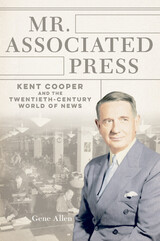 Mr. Associated Press: Kent Cooper and the Twentieth-Century World of News
Gene Allen
University of Illinois Press, 2023 Between 1925 and 1951, Kent Cooper transformed the Associated Press, making it the world’s dominant news agency while changing the kind of journalism that millions of readers in the United States and other countries relied on. Gene Allen’s biography is a globe-spanning account of how Cooper led and reshaped the most important institution in American--and eventually international--journalism in the mid-twentieth century. Allen critically assesses the many new approaches and causes that Cooper championed: introducing celebrity news and colorful features to a service previously known for stodgy reliability, pushing through disruptive technological innovations like the instantaneous transmission of news photos, and leading a crusade to bring American-style press freedom--inseparable from private ownership, in Cooper’s view--to every country. His insistence on truthfulness and impartiality presents a sharp contrast to much of today’s fractured journalistic landscape. Deeply researched and engagingly written, Mr. Associated Press traces Cooper’s career as he built a new foundation for the modern AP and shaped the twentieth-century world of news.
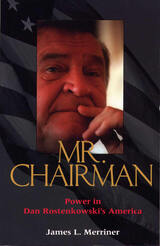 Mr. Chairman: Power in Dan Rostenkowski's America
James L. Merriner
Southern Illinois University Press, 2002 The story of Dan Rostenkowski’s rise and fall provides one of the keys to how power is sought, won, exercised, and distributed in contemporary America, argues political journalist James L. Merriner. A literal son of the Chicago political machine, Rostenkowski was installed in politics by his father, Alderman Joseph P. Rostenkowski, and by his mentor, Mayor Richard I. Daley. In his thirty-six year congressional career, he served nine presidents, forming close friendships with many of them. His legislative masterpiece was the 1986 tax reform law. Eight years later, he was indicted on federal charges for misusing tax dollars and campaign funds. In his dealings with the man who tumbled dramatically from his high position as chair of the powerful House Ways and Means Committee all the way down to a cell in a federal prison in Wisconsin, Merriner finds Rostenkowski candid, straightforward, and authentic— "except when it came to his own finances." Rostenkowski is not a complex man in need of psychoanalysis on the part of his biographer, and Merriner does not indulge in much of that. Purely, simply, and openly, Rostenkowski wanted power. He wanted wealth. He got both, and Merriner shows us how. Merriner sees mythic qualities in Rostenkowski, characterizing him as the "tall bold slugger" of Carl Sandburg’s 1916 poem about Chicago. Noting that this master politician climbed to fantastic peaks only to fall hard and fast, Merriner points out that "Rostenkowski’s life ascended from power in the political science sense to tragedy in the classical sense." The Justice Department and the electorate sacrificed Rostenkowski as an embodiment of the excesses of big government. Like the Greek chorus of tragedy, major media reported the scandal to the masses. Yet Merriner does not strain to make his subject fit a classical mold. He tells instead the "story of a great man who was also a little man, a statesman and a crook, an emotional man, an American original." This was also a man unbeaten by his troubles, a man who emerged from prison unabashed. This illustrated biography is not authorized by Rostenkowski, who declined Merriner’s interview requests after June 1995. His sources are the public record, previous interviews with Rostenkowski and with many other sources before and after 1995, and his own political acumen gained from decades on the political scene.
Mr. Chairman: The Life and Legacy of Wilbur D. Mills
Kay Collett Goss
Parkhurst Brothers, Inc., 2012 No-holds barred bio of national budget czar (during the 1950s and 1960s), Wilbur D. Mills, who was Chairman of the United States House of Representatives Committee on Ways and Means for nineteen years. Mills tutuladge of young congressman, such as George H.W. Bush (the future president #41) and detailed knowledge of the United States Tax Code, as well as his behind-the-scenes network of information and the leanings of congressional members earned him high regard in the eyes of presidents Eisenhower, Kennedy, and Nixon. Mills' career came to an abrupt end when he was found at the Tidal Basin with exotic dancer, Fanny Foxe. The text describes both Mills the powerful politician and Mills' sometimes troubled personal life with clarity and in detail.
Mr. Democrat: Jim Farley, the New Deal and the Making of Modern American Politics
Daniel Scroop
University of Michigan Press, 2006
Mr. Democrat tells the story of Jim Farley, Franklin D. Roosevelt's campaign manager. As party boss, Farley experienced unprecedented success in the New Deal years. And like his modern counterpart Karl Rove, Farley enjoyed unparalleled access and power. Unlike Rove, however, Farley was instrumental in the creation of an overwhelming new majority in American politics, as the emergence of the New Deal transformed the political landscape of its time.
Mr. Democrat is timely and indispensable not just because Farley was a fascinating and unduly neglected figure, but also because an understanding of his career advances our knowledge of how and why he revolutionized the Democratic Party and American politics in the age of the New Deal.
Daniel Scroop is Lecturer in American History, University of Liverpool School of History.
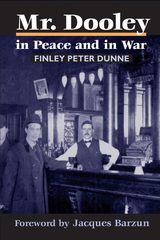 Mr. Dooley in Peace and in War
Finley Peter Dunne
University of Illinois Press, 1988 Welcome to Mr. Dooley's place, a neighborhood saloon in the working-class community of Bridgeport, located on Chicago's near southwest side. Here matters of the gravest import are perused with homespun philosophy and good cheer. Covering the waterfront from Mack's (President McKinley's) foreign policies and political appointments to the Alaskan gold rush and juvenile delinquency, Martin T. Dooley holds forth from behind the bar, benevolently dispensing equal portions of wisdom and comical misunderstanding. As Charlie McCarthy is to Edgar Bergen, so is Martin T. Dooley to newspaper humorist Finley Peter Dunne. Mr. Dooley in Peace and in War, originally published in 1898, collects brief, humorous pieces Dunne wrote for the Chicago Evening Post and the Chicago Journal. In an Irish-American dialect as thick as the foam on a pint of stout, Mr. Dooley and his friends discuss the military "sthrateejy" for American action in Cuba, "iliction" day shenanigans, Queen Victoria's jubilee, the "new woman," and the strange American sport of football, in which a player puts "a pair iv matthresses on his legs, a pillow behind, [and] a mask over his nose" and tries to kill his fellow men. Through his tall tales and speculations, Mr. Dooley reveals the pleasure and pain of being Irish in Chicago at the turn of the twentieth century. Clothed in the charming hyperbole and mislocution of the unflappable Mr. Dooley, Dunne's incisive social criticism flies unerringly to the target, exposing prejudice, hypocrisy, insensitivity, and plain old-fashioned humbug.
 Mr. Goodman the Player
John Harold Wilson
University of Pittsburgh Press, 1964
Famous as an actor with the King’s Company in London during the Restoration, Cardell Goodman epitomized one of the most colorful ages in English history.
Goodman was admitted to St. John’s College, Cambridge at age 13, and, upon graduation, became an actor in the King’s Company. To supplement his meager acting income, he took up highway robbery and was captured then pardoned by King Charles. About 1684, he became the lover of Barbara, Duchess of Cleveland, former mistress of King Charles, and spent the next ten years living in luxury as her Master of the Horse, occasionally accepting acting roles. In 1696 he became entangled in the Jacobite conspiracy and fled to France. He returned to a remote part of England after the Peace of Ryswick in 1697, and spent the last years of his turbulent, exciting, dangerous life in genteel poverty.
John Harold Wilson tells Goodman’s remarkable life story with documentation, grace, and wit, using it to illustrate the violence, intrigue, lawlessness, moral laxity, and brilliance of the era’s revolt against Puritan sobriety and dullness.
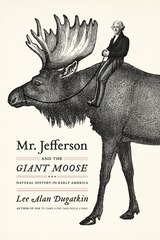 Mr. Jefferson and the Giant Moose: Natural History in Early America
Lee Alan Dugatkin
University of Chicago Press, 2009 In the years after the Revolutionary War, the fledgling republic of America was viewed by many Europeans as a degenerate backwater, populated by subspecies weak and feeble. Chief among these naysayers was the French Count and world-renowned naturalist Georges-Louis Leclerc de Buffon, who wrote that the flora and fauna of America (humans included) were inferior to European specimens. Thomas Jefferson—author of the Declaration of Independence, U.S. president, and ardent naturalist—spent years countering the French conception of American degeneracy. His Notes on Virginia systematically and scientifically dismantled Buffon’s case through a series of tables and equally compelling writing on the nature of his home state. But the book did little to counter the arrogance of the French and hardly satisfied Jefferson’s quest to demonstrate that his young nation was every bit the equal of a well-established Europe. Enter the giant moose. The American moose, which Jefferson claimed was so enormous a European reindeer could walk under it, became the cornerstone of his defense. Convinced that the sight of such a magnificent beast would cause Buffon to revise his claims, Jefferson had the remains of a seven-foot ungulate shipped first class from New Hampshire to Paris. Unfortunately, Buffon died before he could make any revisions to his Histoire Naturelle, but the legend of the moose makes for a fascinating tale about Jefferson’s passion to prove that American nature deserved prestige. In Mr. Jefferson and the Giant Moose, Lee Alan Dugatkin vividly recreates the origin and evolution of the debates about natural history in America and, in so doing, returns the prize moose to its rightful place in American history.
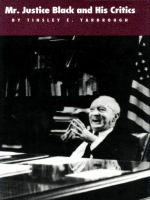 Mr. Justice Black and His Critics
Tinsley E. Yarbrough
Duke University Press, 1988 Many jurists give lip service to the idea that judicial interpretation of constitutional provisions should be based on the intent of the framers. Few, if any, have been as faithful to that conception as Hugo Black. As U.S. senator from Alabama, Black was a vigorous critic of the Supreme Court's use of the Constitution as a weapon against the Roosevelt New Deal. Once on the court he played a leading role in overturning those decisions and in attempting to establish for freedom of speech and other guarantees the interpretation he (and others) believe was warranted by the language and intent of the framers.
Late in his career, however, Black's commitment to literalism and intent led him to assume apparently conservative positions in civil liberties cases. In an era characterized by growing acceptance of the belief that judges should adapt the Constitution to changing social and ethical perceptions, many came to regard Black's position as unrealistic and irrelevant.
Tinsley E. Yarbrough analyzes Black's judicial and constitutional philosophy, as well as his approach to specific cases, through the eyes of Black's critics (such as Justices Frankfurter and Harlan) and through an assessment of scholarly opinion of his jurisprudence. The result is a stimulating and provocative addition to the study of Justice Black and the Supreme Court.
Mr. Justice Holmes and the Supreme Court: Second Edition
Felix Frankfurter
Harvard University Press Although Mr. Justice Holmes resigned from the Supreme Court on the eve of the conflict between the Court and the New Deal, all the forces of that conflict were developing during the thirty years of his membership. The major controversies that came before the Court during that period are considered in the three essays in this volume. Since it is intended for the lay-reader, the legal issues are set in the prospective of contemporary history. The titles of the essays indicate their scope: Property and Society; Civil Liberties and the Individual; and the Federal System.
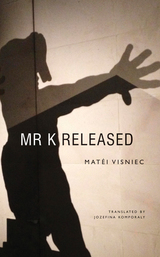 Mr. K Released
Matéi Visniec
Seagull Books, 2019 Mirroring Romania’s drastic transition from totalitarianism to Western-style freedom in the late 1980s, Mr. K Released captures the disturbingly surreal feeling that many newly liberated prisoners face when they leave captivity. Employing his trademark playful absurdity, Matéi Visniec introduces us to Mr. K, a Kafkaesque figure who has been imprisoned for years for an undisclosed crime in a penitentiary with mysterious tunnels.
One day, Mr. K finds himself unexpectedly released. Unable to comprehend his sudden liberation, he becomes traumatized by the realities of freedom—more so than the familiar trauma of captivity or imprisonment. In the hope of obtaining some clarification, Mr. K keeps waiting for an appointment with the prison governor, however, their meeting is constantly being delayed. During this endless process of waiting, Mr. K gets caught up in a clinical exploration of his physical surroundings. He does not have the courage or indeed inclination to leave, but can move unrestricted within the prison compound, charting endless series of absurd circles in which readers might paradoxically recognize themselves.
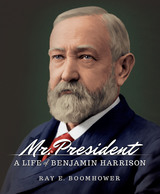 Mr. President: A Life of Benjamin Harrison
Ray E. Boomhower
Indiana Historical Society Press, 2018 Mr. President: A Life of Benjamin Harrison, the thirteenth volume in the Indiana Historical Society Press’s youth biography series, examines Harrison’s rise to political prominence after his service as a Union army general during the Civil War.
Although he served only one term, defeated for re-election by Cleveland in 1892, Harrison had some impressive achievements during his four years in the White House. His administration worked to have Congress pass the Sherman Antitrust Act to limit business monopolies, fought to protect voting rights for African American citizens in the South, preserved millions of acres for forest reserves and national parks, modernized the American navy, and negotiated several successful trade agreements with other countries in the Western Hemisphere.
After losing the White House, Harrison returned to Indianapolis, once again becoming one of the city’s leading citizens. He died from pneumonia on March 13, 1901, in his home on North Delaware Street, today open to the public as the Benjamin Harrison Presidential Site.
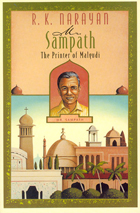 Mr. Sampath--the Printer of Malgudi
R. K. Narayan
University of Chicago Press, 1949 "There are writers—Tolstoy and Henry James to name two—whom we hold in awe, writers—Turgenev and Chekhov—for whom we feel a personal affection, other writers whom we respect—Conrad for example—but who hold us at a long arm's length with their 'courtly foreign grace.' Narayan (whom I don't hesitate to name in such a context) more than any of them wakes in me a spring of gratitude, for he has offered me a second home. Without him I could never have known what it is like to be Indian."—Graham Greene
Offering rare insight into the complexities of Indian middle-class society, R. K. Narayan traces life in the fictional town of Malgudi. The Dark Room is a searching look at a difficult marriage and a woman who eventually rebels against the demands of being a good and obedient wife. In Mr. Sampath, a newspaper man tries to keep his paper afloat in the face of social and economic changes sweeping India. Narayan writes of youth and young adulthood in the semiautobiographical Swami and Friends and The Bachelor of Arts. Although the ordinary tensions of maturing are heightened by the particular circumstances of pre-partition India, Narayan provides a universal vision of childhood, early love and grief.
"The experience of reading one of his novels is . . . comparable to one's first reaction to the great Russian novels: the fresh realization of the common humanity of all peoples, underlain by a simultaneous sense of strangeness—like one's own reflection seen in a green twilight."—Margaret Parton, New York Herald Tribune
"Narayan's limits are meticulously imposed and observed but his humor and compassion come from a deep universal well, with the result that he has transformed his imaginary township of Malgudi into a bubbling parish of the world."—Christopher Wordsworth, Observer
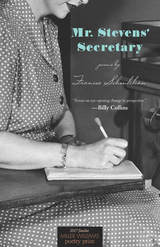 Mr. Stevens' Secretary: Poems
Frances Schenkkan
University of Arkansas Press, 2017 Finalist, 2017 Miller Williams Poetry Prize, edited by Billy Collins “Forces an eye-opening change in perspective.” —Billy Collins In Mr. Stevens’ Secretary, a fictional assistant to Wallace Stevens juggles her roles as a mother, a wife, a believer, and a working woman. Privy at times to the famous poet’s personal life, the secretary must balance her curiosity about Stevens with her commitment to her husband, her faith, and the life she desires. This vivid and compelling character struggles with fears of mental illness and the challenges of working for a prominent, reserved man, all while adjusting to new environs. She leaves her home, and her job, as she contemplates whether her marriage is worth saving and if she can reconcile the Baptist faith of her upbringing with the questions raised by her new place in the world. Throughout, we are witness to her complex relationship with the famous modernist poet, and with writing itself.
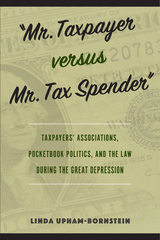 "Mr. Taxpayer versus Mr. Tax Spender": Taxpayers' Associations, Pocketbook Politics, and the Law during the Great Depression
Linda Upham-Bornstein
Temple University Press, 2023 During the Great Depression, the proliferation of local taxpayers’ associations was dramatic and unprecedented. The justly concerned members of these organizations examined the operations of state, city, and county governments, then pressed local officials for operational and fiscal reforms. These associations aimed to reduce the cost of state and local governments to make operations more efficient and less expensive.
“Mr. Taxpayer versus Mr. Tax Spender” presents a comprehensive overview of these grassroots taxpayers’ leagues beginning in the 1860s and shows how they evolved during their heyday in the 1930s. Linda Upham-Bornstein chronicles the ways these taxpayers associations organized as well as the tools they used—constructive economy, political efforts, tax strikes, and tax revolt through litigation—to achieve their objectives.
Taxpayer activity was a direct consequence of—and a response to—the economic crisis of the Great Depression and the expansion of the size and scope of government. “Mr. Taxpayer versus Mr. Tax Spender” connects collective tax resistance in the 1930s to the populist tradition in American politics and to other broad impulses in American political and legal history.
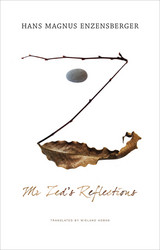 Mr Zed’s Reflections
Hans Magnus Enzensberger
Seagull Books, 2015 Any new book by poet, essayist, writer, and translator Hans Magnus Enzensberger, one of the most influential and internationally renowned German intellectuals, is cause for notice, and Mr. Zed’s Reflections is no exception. Every afternoon for almost a year, a plump man named Mr. Zed comes to the same spot in the city park and engages passersby with quick-witted repartee. Those who pass ask, who is this man? A wisecracker, a clown, a belligerent philosopher? Many shake their heads and move on; others listen to him, engage with him, and, again and again, end up at the same place. He doesn’t write anything down, but his listeners often take notes. With subversive energy and masterful brevity, Mr. Zed undermines arrogance, megalomania, and false authority. A determined speaker who doesn’t care for ambitions, he forces topics that others would rather keep to themselves. Reluctant to trust institutions and seeing absolutely nothing as “non-negotiable,” he admits mistakes and does away with judgment. He is no mere ventriloquist dummy for his creator—he is too stubborn for that. And at the end of the season, when it becomes too cold and uncomfortable in the park, he disappears, never to be seen again.
Collected in this thought-provoking and unique work are the considerations and provocations of this squat, park-bench philosopher, giving us a volume of truths and conversations that are clear-cut, skeptical, and fiercely illuminating.
MRE vol 29 num 1
The University of Chicago Press
University of Chicago Press Journals, 2014
MRE vol 29 num 2
The University of Chicago Press
University of Chicago Press Journals, 2014
MRE vol 29 num 3
The University of Chicago Press
University of Chicago Press Journals, 2014
MRE vol 29 num 4
The University of Chicago Press
University of Chicago Press Journals, 2014
MRE vol 30 num 1
The University of Chicago Press
University of Chicago Press Journals, 2015
MRE vol 30 num 2
The University of Chicago Press
University of Chicago Press Journals, 2015
MRE vol 30 num 3
The University of Chicago Press
University of Chicago Press Journals, 2015
MRE vol 30 num 4
The University of Chicago Press
University of Chicago Press Journals, 2015
MRE vol 31 num 1
The University of Chicago Press
University of Chicago Press Journals, 2016
MRE vol 31 num 2
The University of Chicago Press
University of Chicago Press Journals, 2016
MRE vol 31 num 3
The University of Chicago Press
University of Chicago Press Journals, 2016
MRE vol 31 num 4
The University of Chicago Press
University of Chicago Press Journals, 2016
MRE vol 32 num 1
The University of Chicago Press
University of Chicago Press Journals, 2017
MRE vol 32 num 2
The University of Chicago Press
University of Chicago Press Journals, 2017
MRE vol 32 num 3
The University of Chicago Press
University of Chicago Press Journals, 2017
MRE vol 32 num 4
The University of Chicago Press
University of Chicago Press Journals, 2017
MRE vol 33 num 1
The University of Chicago Press
University of Chicago Press Journals, 2018
MRE vol 33 num 2
The University of Chicago Press
University of Chicago Press Journals, 2018
MRE vol 33 num 3
The University of Chicago Press
University of Chicago Press Journals, 2018
MRE vol 33 num 4
The University of Chicago Press
University of Chicago Press Journals, 2018
MRE vol 34 num 1
The University of Chicago Press
University of Chicago Press Journals, 2019
MRE vol 34 num 2
The University of Chicago Press
University of Chicago Press Journals, 2019
MRE vol 34 num 3
The University of Chicago Press
University of Chicago Press Journals, 2019
MRE vol 34 num 4
The University of Chicago Press
University of Chicago Press Journals, 2019
MRE vol 35 num 1
The University of Chicago Press
University of Chicago Press Journals, 2020 This is volume 35 issue 1 of Marine Resource Economics. Marine Resource Economics (MRE) publishes creative and scholarly economic analyses of a range of issues related to natural resource use in the global marine environment. The scope of the journal includes conceptual and empirical investigations aimed at addressing real-world ocean and coastal policy problems. MRE is an outlet for early results and imaginative new thinking on emerging topics in the marine environment, as well as rigorous theoretical and empirical analyses of questions that have long interested economists who study the oceans. A pluralistic forum for researchers and policy makers, MRE encourages challenges to conventional paradigms and perspectives. The journal is comprised of five sections: Articles, Perspectives, Case Studies, Systematic Reviews, and Book Reviews.
MRE vol 35 num 2
The University of Chicago Press
University of Chicago Press Journals, 2020
MRE vol 35 num 3
The University of Chicago Press
University of Chicago Press Journals, 2020
MRE vol 35 num 4
The University of Chicago Press
University of Chicago Press Journals, 2020
MRE vol 36 num 1
The University of Chicago Press
University of Chicago Press Journals, 2021
 Mrs. Abraham Lincoln: A Study of Her Personality and Her Influence on Lincoln
W.A. Evans, Foreword by Jason Emerson
Southern Illinois University Press, 1932 First published in 1932, this was the first thoroughly researched biography of Mary Lincoln ever written, and it remains the most balanced and complete work on this controversial First Lady. Author W. A. Evans challenges the disparaging views of Mary Lincoln that were generally accepted at the time, offering a comprehensive and informed look at a woman whose physical and mental health problems have often been misconstrued or overlooked by other biographers. Evans conducted extensive research, interviewing Mrs. Lincoln’s family members, seeking advice and assistance from numerous Lincoln scholars and historians, scouring thousands of pages of contemporary newspapers and primary resources, reviewing correspondence Mary wrote during her stay at Bellevue Place sanitarium, and consulting with several medical experts. The result of all this research is an objective and detailed portrait of Mrs. Lincoln and her influence on her husband that still has a great deal of historical value for readers today.
A new foreword by Jason Emerson, author of The Madness of Mary Lincoln, provides biographical information on Evans and background on the origins of the book and its reception and influence. Finally back in print, this classic biography is essential reading for all with an interest in the Lincoln family.
Mrs. Dumpty
Chana Bloch
University of Wisconsin Press, 1998 The poems in Mrs. Dumpty are about “a great fall,” the dissolution of a long and loving marriage, but they are not simply documentary or elegiac. What interests Chana Bloch is the inner life: how we are formed by our losses and our parents’ losses, how we learn what we need to know through our intuitions and confusions, how we deny and delay and finally discover who we are.
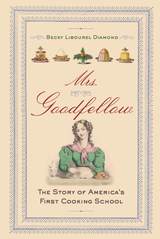 Mrs. Goodfellow: The Story of America's First Cooking School
Becky Libourel Diamond
Westholme Publishing, 2012 Recovering the Life and Influence of the “Mother of American Cooking,” the Woman Who Changed the Way We Learn How to Prepare Meals In Philadelphia during the first decades of the nineteenth century, a widow, Mrs. Elizabeth Goodfellow, ran a popular bakery and sweet shop. In addition to catering to Philadelphia’s wealthy families and a reputation of having the finest desserts and sweet dishes in the young country, her business stood out from every other establishment in another way: she ran a small school to learn the art of cooking, the first of its kind in America. Despite her fame—references to her cooking as a benchmark abound in the literature of the period—we know very little about who she was. Since she did not keep a journal and never published any of her recipes, we have to rely on her students, most notably Eliza Leslie, who fortunately recorded many of Goodfellow’s creations and techniques. Goodfellow is known to have made the first lemon meringue pie and for popularizing regional foods, such as Indian (corn) meal. Her students also recall that Mrs. Goodfellow stressed using simple wholesome ingredients that were locally grown, presaging modern culinary fashion. By assembling the many parts of this puzzle from old recipe books, advertisements, letters, diaries, genealogical records, and other primary sources, researcher and writer Becky Diamond has been able to provide a more complete portrait of this influential figure in cooking history. Mrs. Goodfellow: The Story of America’s First Cooking School begins with what we know about Elizabeth Goodfellow—where she was born, her husbands, her children, where her shop was located. We then travel back in time to discover the kinds of foods that would have been available to Goodfellow and how she may have used them. The book next turns to the rise of both commercial eating establishements and books of recipes. From here, the author explains the rapid expansion of cooking schools, such as the New York Cooking Academy and the Boston Cooking School, made famous through its association with Fannie Farmer, and ends with a discussion of the role of celebrity chefs. Thoroughly researched and including a range of authentic recipes, Mrs. Goodfellow is a delicious exploration of the life and legacy of one of America’s most influential cooks.
Mrs Kleofas’s Rooster: Three Novellas
Gyula Krúdy
Seagull Books, 2026 A trio of darkly elegant, women-centric novellas from a master of twentieth-century Hungarian literature.
Mrs Kleofas’ Rooster brings together three captivating novellas by Gyula Krúdy, originally written in the 1920s and now available in English for the first time. Each story centers on a woman protagonist: a timeless adventuress, a resilient single mother, and a seductive Budapest femme fatale, respectively. In the title novella, a roguish narrator listens to the thrilling life story of an ageless, mysterious woman whose journey takes her from a childhood of suffering to a career as a cunning accomplice in daring schemes. The next story, NN, follows the life of a steadfast single mother, Juliska, amid the rhythms of village life. In Autumn Meeting, Krudy’s sharp wit unfolds through Rizili, a charming yet ruthless socialite who leads a suspended jockey on an intoxicating night through Budapest’s City Park.
Mrs. Ramsay's Knee
Idris Anderson
Utah State University Press, 2008 Volume 12 in the Swenson Poetry Award Series, Mrs. Ramsay's Knee offers fresh and elegant poems by Idris anderson, many of them ekphrastic considerations of visual works of art. Among her subjects are paintings by Rembrandt, Rousseau, Pollock, and Chagall, yet she equally explores a set of news photos from the 2006 war between Israel and Hezbollah.
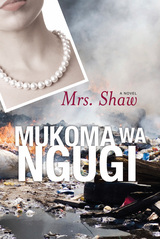 Mrs. Shaw: A Novel
Mukoma Wa Ngugi
Ohio University Press, 2015 In the fictional East African Kwatee Republic of the 1990s, the dictatorship is about to fall, and the nation’s exiles are preparing to return. One of these exiles, a young man named Kalumba, is a graduate student in the United States, where he encounters Mrs. Shaw, a professor emerita and former British settler who fled Kwatee’s postcolonial political and social turmoil. Kalumba’s girlfriend, too, is an exile: a Puerto Rican nationalist like her imprisoned father, she is an outcast from the island. Brought together by a history of violence and betrayals, all three are seeking a way of regaining their humanity, connecting with each other, and learning to make a life in a new land. Kalumba and Mrs. Shaw, in particular, are linked by a past rooted in colonial and postcolonial violence, yet they are separated by their differing accounts of what really happened. The memory of each is subject to certain lapses, whether selective or genuine. Even when they agree on the facts—be they acts of love, of betrayal, or of violence—each narrator shapes the story in his or her own way, by what is left in and what is left out, by what is remembered and what is forgotten.
 Mrs. Shipley's Ghost: The Right to Travel and Terrorist Watchlists
Jeffrey Kahn
University of Michigan Press, 2014 Today, when a single person can turn an airplane into a guided missile, no one objects to rigorous security before flying. But can the state simply declare some people too dangerous to travel, ever and anywhere? Does the Constitution protect a fundamental right to travel? Should the mode of travel (car, plane, or boat) or itinerary (domestic or international) make a constitutional difference? This book explores the legal and policy questions raised by government travel restrictions, from passports and rubber stamps to computerized terrorist watchlists. In tracing the history and scope of U.S. travel regulations, Jeffrey Kahn begins with the fascinating story of Mrs. Ruth Shipley, a federal employee who almost single-handedly controlled access to passports during the Cold War. Kahn questions how far national security policies should go and whether the government should be able to declare some individuals simply too dangerous to travel. An expert on constitutional law, Kahn argues that U.S. citizens’ freedom to leave the country and return is a fundamental right, protected by the Constitution.
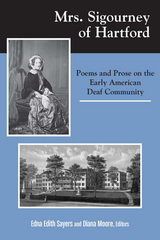 Mrs. Sigourney of Hartford: Poems and Prose on the Early American Deaf Community
Edna Edith Sayers
Gallaudet University Press, 2013 Lydia Huntley was born in 1791 in Norwich, CT, the only child of a poor Revolutionary war veteran. But her father’s employer, a wealthy widow, gave young Lydia the run of her library and later sent her for visits to Hartford, CT. After teaching at her own school for several years in Norwich, Lydia returned to Hartford to head a class of 15 girls from the best families. Among her students was Alice Cogswell, a deaf girl soon to be famous as a student of Thomas Hopkins Gallaudet and Laurent Clerc.
Lydia’s inspiration came from a deep commitment to the education of girls and also for African American, American Indian, and deaf children. She left teaching to marry Charles Sigourney, then turned to writing to support her family, publishing 56 books, 2,000 magazine articles, and popular poetry. Lydia Sigourney never abandoned her passion for deaf education, remaining a supporter of Gallaudet’s school for the deaf until her death. Yet, her contributions to deaf education and her writing have been forgotten until now.
All of Lydia Sigourney’s of Lydia Sigourney’s work on the nascent Deaf community is presented in this new volume. Her writing intertwines her mastery of the sentimentalism form popular in her day with her sharp insights on the best ways to educate deaf children. In the process, Mrs. Sigourney of Hartford reestablishes her rightful place in history.
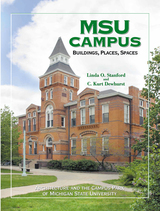 MSU Campus—Buildings, Places, Spaces: Architecture and the Campus Park of Michigan State University
Linda O. Stanford
Michigan State University Press, 2002 Since its founding in 1855, Michigan State University has emerged from its modest “oak opening” in the wilderness to become a large campus park. This story reflects the commitment of campus leaders since the nineteenth century to develop MSU as a beautiful and educational public resource, as well as a demonstration model, befitting the premier land-grant institution in the United States.
From early landscape gardeners influenced by Ossian Simonds and the nationally known Olmsted Brothers, to the vision of President John Hannah, the consistent intent has been to interrelate architecture and the campus park. The result is a campus whose development reflects major trends in American architecture and whose contributors include local, regional, and nationally known architectural firms. In MSU Campus—Buildings, Places, Spaces, two Michigan State University professors provide a history and way of seeing the campus by offering eight areas to explore.
Each area includes selected historical sites or markers, public art, and natural locations that complement more than one hundred extant buildings, complete with individual stylistic and historical descriptions and photographs. Historical facts about Michigan State University, suggestions for further reading, and an ample glossary of architectural terms make this book a resource for anyone who is interested in Michigan State University, art and architectural history, Michigan history, and visual culture.
The book will continue to serve as a documentary reminder of MSU’s heritage and vital institutional future long after the 2005 sesquicentennial.
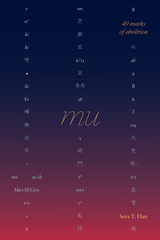 Mu, 49 Marks of Abolition
Sora Y. Han
Duke University Press, 2024 In March 2020, Sora Y. Han learned her father was dying of cancer just as the COVID-19 pandemic arrived on California's shores. These two events led Han to introspection: “Who have I been writing to?” and “Who have I been writing for?” In her observance of the 49 days of mourning in Buddhist tradition, answers come in the form of mu – no thing, nothingness. Han’s poetic meditations on freedom struggle come alive in the empty spaces between words, letters, and pictograms spanning her many languages—English, Korean, Chinese, jazz, law, and poetry. Transliterating and dystranslating the writings of Fred Moten, Theresa Hak Kyung Cha, Jacques Lacan, Frantz Fanon, and others through the Korean alphabet, Han weaves the DMZ, Betty’s Case, the Thirteenth Amendment, Afro-pessimism, and psychoanalytic desire together into the open field of Bay Area radicalism. Mu is both a loving homage to and a playful subversion of political inheritances and the unsayable beyond law.
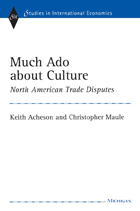 Much Ado about Culture: North American Trade Disputes
Keith Acheson and Christopher Maule
University of Michigan Press, 2001 In Canada, the audio-visual and print industries are referred to as the cultural industries, whereas the United States calls them the entertainment industries. These language distinctions are accompanied by different domestic policies and political discourses. The United States has relatively open policies toward these activities, while Canada has adopted an inward-looking approach. Failure to integrate cultural industries into NAFTA and WTO has led to trade disputes between Canada and the United States over copyrights, television licensing, violence in media, and discriminatory magazine policy, indicating the need for an agreed-upon process for settling cultural trade disputes.
Much Ado about Culture explores the differing sets of policies--cultural nationalism versus the open option--and the resulting conflicts in the context of technological developments as well as international agreements dealing with trade, investment, copyright, and labor movements. The Canadian cultural industries are examined, from film and television production and distribution to broadcasting, publishing, and sound recording. Several areas of recent conflict, such as Sports Illustrated, Country Music Television, and Borders Books, highlight the types of policies disputed, the process followed, and the conclusions reached. Finally, the authors propose an alternative approach to constraining national cultural policies by international agreement that would allow the gains from openness to be realized while serving legitimate cultural concerns.
Authored by the acknowledged experts on trade disputes in the cultural arena, this book will be essential reading for international economists, policymakers, and lawyers interested in the cultural industries.
Keith Acheson and Christopher Maule are Professors of Economics, Carleton University, Ontario.
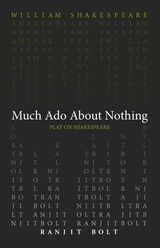 Much Ado About Nothing
William Shakespeare
Arizona Center for Medieval and Renaissance Studies, 2021 Ranjit Bolt updates Much Ado About Nothing with a merry new translation.
In Much Ado About Nothing, a series of miscommunications and misunderstandings spiral out of control, leaving two sets of lovers to untangle their words and their hearts. Ranjit Bolt, an accomplished translator, takes on Shakespeare’s well-loved comedy to update much of the obscure language while maintaining the humor, characterization, and wit that audiences know and love. For modern readers, Beatrice, Benedick, Hero, and Claudio are just as enchanting as always—and perhaps funnier than ever before.
This translation of Much Ado About Nothing was written as part of the Oregon Shakespeare Festival’s Play On! project, which commissioned new translations of thirty-nine Shakespeare plays. These translations present work from “The Bard” in language accessible to modern audiences while never losing the beauty of Shakespeare’s verse. Enlisting the talents of a diverse group of contemporary playwrights, screenwriters, and dramaturges from diverse backgrounds, this project reenvisions Shakespeare for the twenty-first century. These volumes make these works available for the first time in print—a new First Folio for a new era.
Much Maligned Monsters: A History of European Reactions to Indian Art
Partha Mitter
University of Chicago Press, 1992 In this fascinating study, Partha Mitter traces the history of European reactions to Indian art, from the earliest encounters of explorers with the exotic. East to the more sophisticated but still incomplete appreciations of the early twentieth century. Mitter's new Preface reflects upon the profound changes in Western interpretations of non-Western societies over the past fifteen years.
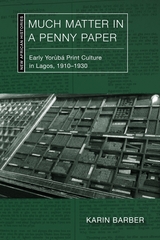 Much Matter in a Penny Paper: Early Yorùbá Print Culture in Lagos, 1910–1930
Karin Barber
Ohio University Press A groundbreaking study of Yorùbá-language print culture in colonial Lagos Much Matter in a Penny Paper offers the first in-depth exploration of the emergence of an African-language print culture in early twentieth-century Lagos, Nigeria. Focusing on the 1910s and 1920s—a period of rapid experimentation and innovation—Karin Barber examines the rise of Yorùbá-language newspapers and the vibrant civic sphere they helped create. The 1910s was notable for an upsurge of local Yorùbá-language history books, and during the 1920s entrepreneurial editors and writers launched five Yorùbá-language weeklies in quick succession. These publications drew in readers beyond the educated elite, expanding public discourse and experimenting with new genres of writing. From moralizing pamphlets and dramatic sketches to serialized narratives voiced by women, Yorùbá print producers reimagined oral and written traditions, blending popular songs, anecdotes, and poetic forms into a dynamic new medium. This book is about not only what was printed but also how and why. It investigates the material practices of print production, the motivations of its creators, and the expectations of its audiences. Drawing on editorials, reader correspondence, and other paratextual commentary, it reveals how Yorùbá writers and readers understood the role of print in capturing the present, preserving the past, projecting the wisdom of the day forward for the benefit of future generations, and generating deep Yorùbá texts rich in poetic energy. Through detailed portraits of key figures—editors, pamphleteers, and a mysterious oral historian—Barber traces the interconnections between publications and genres, showing how they formed an active bilingual sphere of communication. The interplay between Yorùbá- and English-language media, as well as the creative exploitation of both languages, emerges as a defining feature of this period’s print culture. By treating the Yorùbá print archive as a “transcript of emergence,” this study offers new insights into how cultural innovations take shape. It is essential reading for scholars of African history, media studies, sociolinguistics, and print culture.
 The Muckrakers
Edited by Arthur Weinberg and Lila Weinberg
University of Illinois Press, 1964 As the twentieth century opened, Americans were jolted out of their laissez-faire complacency by detailed exposures, in journalism and fiction, of the corruption underlying the country's greatest institutions. This rude awakening was the work of the muckrakers, as Theodore Roosevelt christened these press agents for reform.
From 1902, when it latched onto such mass circulation magazines as Collier's and McClure's, until it merged into the Progressive movement in 1912, muckraking relentlessly pricked the nation's social conscience by exposing the abuses of industry and politics. Ranging in tone from the scholarly to the sensational, muckraking articles attacked food adulteration, unscrupulous insurance practices, fraudulent claims for patent medicines, and links between government and vice. When muckrakers raised their voices against child labor, graft, monopoly, unsafe mill conditions, and the white slave trade of poor immigrant girls, they found a receptive audience. "I aimed at the public's heart," wrote Upton Sinclair about The Jungle, "and by accident I hit it in the stomach."
Gathering the most significant pieces published during the heyday of the muckraking movement, The Muckrakers brings vividly to life this unique era of exposure and self-examination. For each article, Arthur and Lila Weinberg provide concise commentary on the background of its subject and the specific and long-range repercussions of its publication. The volume features the work of both journalists and fiction writers, including Ida Tarbell, Lincoln Steffens, Upton Sinclair, Ray Stannard Baker, Samuel Hopkins Adams, Thomas W. Lawson, Charles Edward Russell, and Mark Sullivan.
Eloquent and uncompromising, the muckrakers shocked America from a state of lethargy into Progressive reform. This generous volume vividly captures the urgency of their quest.
Mud in Our Mouths: Poems
Luiza Flynn-Goodlett
Northwestern University Press, 2025 An award-winning poet writing through violence, solace, and hope Luiza Flynn-Goodlett’s Mud in Our Mouths illuminates how we are all enmeshed in a web of violence and love. As the speaker of the collection drives cross-country to visit her family of origin in Tennessee, she reckons with the tensions between her current and past selves and the many ways violence—interpersonal, societal, and environmental—has shaped her life. She struggles to find meaning, questioning the ethics of locating faith in a natural world she is unintentionally destroying, and grapples with her complicity in systems of power and oppression as a white Southern woman. Ultimately, she rejects the idea of genetic family as a place of solace; instead, she cleaves to the liberation and joy of connections forged outside those strictures, where intimacy is freely chosen rather than preordained.
 Mud on the Stars
William Bradford Huie
University of Alabama Press, 1996 William Bradford Huie’s first novel, Mud on the Stars, is largely autobiographical and is set in the years 1929-1942. As in many of his later books, the theme here is of the education of the inexperienced youth, which is, after all, the quintessential American story. Drawing on his own boyhood, Huie gives the reader a detailed account of rural life and race relations in the Tennessee Valley in the early years of this century, including a vivid picture of college life at The University of Alabama during the Great Depression. Through a careful weaving of characters and events, fact and fiction, Huie’s novel captures the tumultuous times before World War II in the urban South, times of social unrest and testing of new political ideologies. The book’s publication in 1942 was a huge financial success, by the economic standards of the day, and not only brought Huie the acclaim his talent warranted but also focused an approving national spotlight on this prolific Alabama writer.
Mud Woman: Poems from the Clay
Nora Naranjo-Morse
University of Arizona Press, 1992 The clay sculptures of Nora Naranjo-Morse have been critically hailed for both their humor and their blending of traditional and modern styles. Now with Mud Woman she calls on her equal talent as a poet, juxtaposing clay and words to capture not only the essence of the creative process but also the satisfactions and complications of what it means to be a Pueblo Indian woman in the late twentieth century.
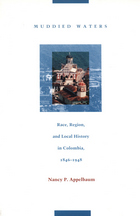 Muddied Waters: Race, Region, and Local History in Colombia, 1846–1948
Nancy P. Appelbaum
Duke University Press, 2003 Colombia’s western Coffee Region is renowned for the whiteness of its inhabitants, who are often described as respectable pioneer families who domesticated a wild frontier and planted coffee on the forested slopes of the Andes. Some local inhabitants, however, tell a different tale—of white migrants rapaciously usurping the lands of indigenous and black communities. Muddied Waters examines both of these legends, showing how local communities, settlers, speculators, and politicians struggled over jurisdictional boundaries and the privatization of communal lands in the creation of the Coffee Region. Viewing the emergence of this region from the perspective of Riosucio, a multiracial town within it, Nancy P. Appelbaum reveals the contingent and contested nature of Colombia’s racialized regional identities. Nineteenth- and twentieth-century Colombian elite intellectuals, Appelbaum contends, mapped race onto their mountainous topography by defining regions in racial terms. They privileged certain places and inhabitants as white and modern and denigrated others as racially inferior and backward. Inhabitants of Riosucio, however, elaborated local narratives about their mestizo and indigenous identities that contested the white mystique of the Coffee Region. Ongoing violent conflicts over land and politics, Appelbaum finds, continue to shape local debates over history and identity. Drawing on archival and published sources complemented by oral history, Muddied Waters vividly illustrates the relationship of mythmaking and racial inequality to regionalism and frontier colonization in postcolonial Latin America.
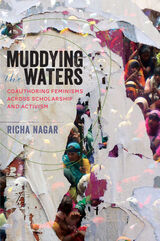 Muddying the Waters: Coauthoring Feminisms across Scholarship and Activism
Richa Nagar
University of Illinois Press, 2014 In Muddying the Waters, Richa Nagar embarks on an eloquent and moving exploration of the promises and pitfalls she has encountered during her two decades of transnational feminist work. With stories, encounters, and anecdotes as well as methodological reflections, Nagar grapples with the complexity of working through solidarities, responsibility, and ethics while involved in politically engaged scholarship. Experiences that range from the streets of Dar es Salaam to farms and development offices in North India inform discussion of the labor and politics of coauthorship, translation, and genre blending in research and writing that cross multiple--and often difficult--borders. The author links the implicit assumptions, issues, and questions involved with scholarship and political action, and explores the epistemological risks and possibilities of creative research that bring these into intimate dialogue Daringly self-conscious, Muddying the Waters reveals a politically engaged researcher and writer working to become ""radically vulnerable,"" and the ways in which such radical vulnerability can allow a re-imagining of collaboration that opens up new avenues to collective dreaming and laboring across sociopolitical, geographical, linguistic, and institutional borders.
 Mughal Arcadia: Persian Literature in an Indian Court
Sunil Sharma
Harvard University Press, 2017 At its height in the sixteenth and seventeenth centuries, the Mughal Empire was one of the largest empires in Eurasia, with territory extending over most of the Indian subcontinent and much of present-day Afghanistan. As part of the Persianate world that spanned from the Bosphorus to the Bay of Bengal, Mughal rulers were legendary connoisseurs of the arts. Their patronage attracted poets, artists, and scholars from all parts of the eastern Islamic world. Persian was the language of the court, and poets from Safavid Iran played a significant role in the cultural life of the nobility. Mughal Arcadia explores the rise and decline of Persian court poetry in India and the invention of an enduring idea—found in poetry, prose, paintings, and architecture—of a literary paradise, a Persian garden located outside Iran, which was perfectly exemplified by the valley of Kashmir.
Poets and artists from Iran moved freely throughout the Mughal empire and encountered a variety of cultures and landscapes that inspired aesthetic experiments which continue to inspire the visual arts, poetry, films, and music in contemporary South Asia. Sunil Sharma takes readers on a dazzling literary journey over a vast geographic terrain and across two centuries, from the accession of the first emperor, Babur, to the throne of Hindustan to the reign of the sixth great Mughal, Aurangzeb, in order to illuminate the life of Persian poetry in India. Along the way, we are offered a rare glimpse into the social and cultural life of the Mughals.
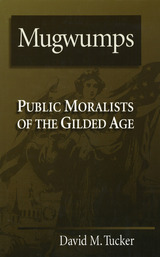 Mugwumps: Public Moralists of the Gilded Age
David M. Tucker
University of Missouri Press, 1998
A spirited reevaluation of the public moralists who shaped public policy in nineteenth-century America, Mugwumps: Public Moralists of the Gilded Age provides a refreshing look at a group of Americans whose importance to the history of our country has commonly been dismissed.
A public interest group that labeled the generation following the American Civil War as the "Gilded Age," Mugwumps were college-educated individuals who lived the lessons of their moral philosophy—Christian values, republican virtue, and classical liberalism. Tracing Mugwump values back before the term was commonly used, Tucker defines these liberals as benevolent and altruistic, active campaigners against slavery and imperialism, and for sound money, lower tariffs, and civil service reform. The earliest Mugwumps took on the self-assigned task of advocating public principles over private interests.
Evaluations of these public moralists during the 1950s and 1960s, however, did not paint the Mugwumps in so positive a light. Awash in the popular New Deal public policies that advocated positive government intervention and regulation in the economy, these studies dismissed Mugwump liberalism as outdated. More specifically, the reformers were criticized as being self-interested failures.
Tucker obliges readers to look beyond such dismissals to the history and accomplishments of Mugwumps as a whole. Unlike previous historians, Tucker examines the antebellum roots of the Mugwumps and follows their ever-increasing participation in American government throughout the nineteenth century. Tucker portrays Mugwumps not as selfish agents of the middle class but as fascinating practitioners of eighteenth-century public virtue and nineteenth-century social science.
This book forcefully challenges previous studies on the Mugwumps and restores these public moralists to the mainstream of nineteenth-century American history. Their concerns for morality and free-market economics are again fashionable in contemporary politics and deserving of fresh attention from both the general reader and the scholar.
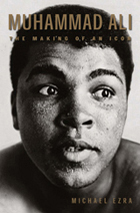 Muhammad Ali: The Making of an Icon
Michael Ezra
Temple University Press, 2009 Muhammad Ali (born Cassius Clay) has always engendered an emotional reaction from the public. From his appearance as an Olympic champion to his iconic status as a national hero, his carefully constructed image and controversial persona has always been intensely scrutinized. In Muhammad Ali, Michael Ezra considers the boxer who calls himself “The Greatest” from a new perspective. He writes about Ali’s pre-championship bouts, the management of his career and his current legacy, exploring the promotional aspects of Ali and how they were wrapped up in political, economic, and cultural “ownership.” Ezra’s incisive study examines the relationships between Ali’s cultural appeal and its commercial manifestations. Citing examples of the boxer’s relationship to the Vietnam War and the Nation of Islam—which serve as barometers of his “public moral authority”—Muhammad Ali analyzes the difficulties of creating and maintaining these cultural images, as well as the impact these themes have on Ali’s meaning to the public.
Muhammad Ali, the People's Champ
Edited by Elliott J. Gorn
University of Illinois Press, 1995 For years recognized as the world's best-known athlete, Muhammad Ali played a fascinating role in American culture, with an influence that reached far beyond sports and, in many ways, defined his times. Ali the boxer stood side by side with Ali the vocal Black Muslim, Ali the cultural force, Ali the anti-war protestor, Ali the celebrity, Ali the narcissist, and more. In Muhammad Ali, the People's Champ, experts unpack Ali's various incarnations to build a vivid portrait of an iconic figure in the ring of public history and reveal how he touched people's lives in ways unprecedented by any sports figure before or since.
 Muhammad and the Believers: At the Origins of Islam
Fred M. Donner
Harvard University Press, 2012 The origins of Islam have been the subject of increasing controversy in recent years. The traditional view, which presents Islam as a self-consciously distinct religion tied to the life and revelations of the prophet Muhammad in western Arabia, has since the 1970s been challenged by historians engaged in critical study of the Muslim sources.
In Muhammad and the Believers, the eminent historian Fred Donner offers a lucid and original vision of how Islam first evolved. He argues that the origins of Islam lie in what we may call the "Believers' movement" begun by the prophet Muhammad—a movement of religious reform emphasizing strict monotheism and righteous behavior in conformity with God's revealed law. The Believers' movement thus included righteous Christians and Jews in its early years, because like the Qur'anic Believers, Christians and Jews were monotheists and agreed to live righteously in obedience to their revealed law. The conviction that Muslims constituted a separate religious community, utterly distinct from Christians and Jews, emerged a century later, when the leaders of the Believers' movement decided that only those who saw the Qur'an as the final revelation of the One God and Muhammad as the final prophet, qualified as Believers. This separated them decisively from monotheists who adhered to the Gospels or Torah.
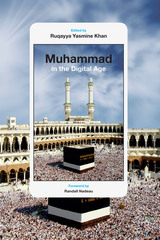 Muhammad in the Digital Age
Edited by Ruqayya Yasmine Khan, foreword by Randall Nadeau
University of Texas Press, 2015 The early twenty-first century has experienced an unrivaled dissemination of information and misinformation about Islam, its prophet Muhammad, and its followers, largely facilitated by the fact that the tragedy of 9/11 roughly coincided with the advent of the digital age. In the first collection of its kind, Ruqayya Khan has compiled essays that treat Muhammad and the core elements of Islam as focal points in an exploration of how the digital era—including social media and other expressions—have both had an effect on and been affected by Islam. Scholars from a variety of fields deal with topics such as the 2005 cartoon controversy in Denmark and the infamous 2012 movie trailer “Innocence of Muslims” that some believe sparked the attacks on the US consulate in Benghazi, as well as how the digitization of ancient texts have allowed the origins of Islam to be studied in new ways. Other essays examine how Muhammad’s wives have been represented in various online sources, including a web comic; the contrasting depictions of Muhammad as both a warrior and peacemaker; and how the widespread distribution of “the look” of Islamic terrorists has led to attacks on Sikhs, whose only point of resemblance to them may be a full beard. These findings illuminate the role of the Internet in forms of representation, advocacy, and engagement concerning Islam and Muslims in our world today.
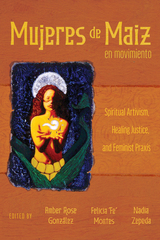 Mujeres de Maiz en Movimiento: Spiritual Artivism, Healing Justice, and Feminist Praxis
Edited by Amber Rose González, Felicia ‘Fe’ Montes, and Nadia Zepeda
University of Arizona Press, 2024 Founded in 1997, Mujeres de Maiz (MdM) is an Indigenous Xicana–led spiritual artivist organization and movement by and for women and feminists of color. Chronicling its quarter-century-long herstory, this collection weaves together diverse stories with attention to their larger sociopolitical contexts. The book crosses conventional genre boundaries through the inclusion of poetry, visual art, testimonios, and essays.
MdM’s political-ethical-spiritual commitments, cultural production, and everyday practices are informed by Indigenous and transnational feminist of color artistic, ceremonial, activist, and intellectual legacies. Contributors fuse stories of celebration, love, and spirit-work with an incisive critique of interlocking oppressions, both intimate and structural, encouraging movement toward “a world where many worlds fit.”
The multidisciplinary, intergenerational, and critical-creative nature of the project coupled with the unique subject matter makes the book a must-have for high school and college students, activist-scholars, artists, community organizers, and others invested in social justice and liberation.
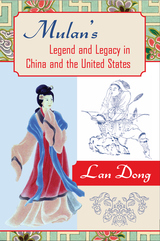 Mulan's Legend and Legacy in China and the United States
Authored by Lan Dong
Temple University Press, 2010 Mulan, the warrior maiden who performed heroic deeds in battle while dressed as a male soldier, has had many incarnations from her first appearance as a heroine in an ancient Chinese folk ballad. Mulan’s story was retold for centuries, extolling the filial virtue of the young woman who placed her father's honor and well-being above her own. With the publication of Maxine Hong Kingston’s The Woman Warrior in the late 1970s, Mulan first became familiar to American audiences who were fascinated with the extraordinary Asian American character. Mulan’s story was recast yet again in the popular 1998 animated Disney film and its sequel. In Mulan’s Legend and Legacy in China and the United States, Lan Dong traces the development of this popular icon and asks, "Who is the real Mulan?" and "What does authenticity mean for the critic looking at this story?" Dong charts this character’s literary voyage across historical and geographical borders, discussing the narratives and images of Mulan over a long time span—from premodern China to the contemporary United States to Mulan’s counter-migration back to her homeland. As Dong shows, Mulan has been reinvented repeatedly in both China and the United States so that her character represents different agendas in each retelling—especially after she reached the western hemisphere. The dutiful and loyal daughter, the fierce, pregnant warrior, and the feisty teenaged heroine—each is Mulan representing an idea about female virtue at a particular time and place.
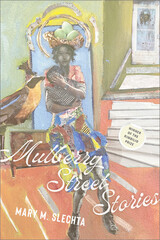 Mulberry Street Stories
Mary Slechta
Four Way Books In this electric collection, Mary Slechta brings magical realism and U.S. history to bear on the community of Mulberry Street— an African-American neighborhood with a disputed past. Is this enclave the result of white flight, a tenuous foothold for Southern transplants, or a sliver of the world that spun off during creation, once ruled by a god named Mr. Washington? Variously featuring the area’s residents, Mulberry Street Stories uphold the perseverance of hope despite intergenerational trauma and demonstrate the interconnection of human lives throughout time. Slechta's characters have seen it all, from the persistent mechanisms of systemic racism—forced migration, redlining, gentrification, and more—to the fantastical—children at danger of falling off a flat world; a vampire posing as Henry Box Brown; and a husband tasked with building a supernatural maze to trap the “somethin,” the faceless oppression that has long plagued his family and now threatens his wife. In one exemplary story, Slechta writes an ode to Toni Morrison, honoring her project to elevate the untold. The protagonist, Marjorie, a griot once charged with remembering things exactly as they happened but now suffering from Alzheimer’s, wanders away during a fugue. Drawn in by a taproom’s enchanting music, she begins orating to strangers, captivating the bartender and unknown patrons, one of whom rests his hand on her limb “like a penny on the arm of a record player”—the touch that keeps the disjointed tales together.
Mule Deer: A Handbook for Utah Hunters and Landowners
Dennis D. Austin
Utah State University Press, 2010 A complete guide to the history, biology, hunting, and management of mule deer in Utah. The author, Dennis D. Austin, is a retired research scientist with more than thirty years of experience working as a wildlife biologist for the Utah Division of Wildlife Resources.
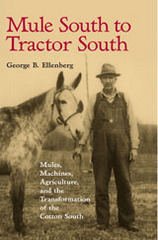 Mule South to Tractor South: Mules, Machines, and the Transformation of the Cotton South
George B. Ellenberg
University of Alabama Press, 2013 The adoption of the mule as the major agricultural resource in the American South and its later displacement by the mechanical tractor
The author describes the adoption of the mule as the major agricultural resource in the American South and its later displacement by the mechanical tractor. After describing the surprising slowness of southern farmers to realize the superiority of the mule over the horse for agricultural labor, Ellenberg strives to capture the symbiosis that emerged between animal and man to illuminate why and how the mule became a standard feature in Southern folk culture. Having been slow to adopt the mule, southern farmers were then reluctant to set it aside in favor of the tractor. Ellenberg describes the transformation as the tractor gradually displaced the mule and the role of the U.S. Department of Agriculture in this process. The work not only becomes a survey of the development of southern agriculture as revealed through an examination of this premier work animal but also follows the emergence of the animal as a cultural icon, as it figures in southern literature, folklore, and music.
Mullahs on the Mainframe: Islam and Modernity among the Daudi Bohras
Jonah Blank
University of Chicago Press, 2001 In Jonah Blank's important, myth-shattering book, the West gets its first look at the Daudi Bohras, a unique Muslim denomination who have found the core of their religious beliefs largely compatible with modern ideology. Combining orthodox Muslim prayer, dress, and practice with secular education, relative gender equality, and Internet use, this community serves as a surprising reminder that the central values of "modernity" are hardly limited to the West.
Multicore Simulation of Power System Transients
Fabian M. Uriarte
The Institution of Engineering and Technology, 2013 Multicore technology has brought about the reexamination of traditional power system electromagnetic transient simulation methods. The technological penetration of this advancement in power system simulation is not noticeable, but its demand is growing in importance in anticipation of the many-core shift. The availability of this technology in personal computers has orchestrated the redesign of simulation approaches throughout the software industry - and in particular, the parallelization of power system simulation.
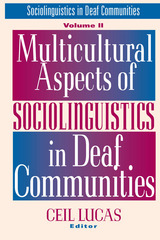 Multicultural Aspects of Sociolinguistics in Deaf Communities
Ceil Lucas
Gallaudet University Press, 2001 This collection offers a wide variety of fascinating studies that consider multicultural aspects among deaf people worldwide. Mala Kleinfeld and Noni Warner investigate variation in the use of gay, lesbian, and bisexual signs in the Deaf community; Jan Branson, Don Miller, and I Gede Marsaja, assisted by I Wayan Negara, profile a deaf village in Bali, Indonesia in which hearing people are fluent in both sign and spoken languages. Alejandro Oviedo in Venezuela comments on bilingual deaf education in Venezuela, and Sara Schley outlines the sociolinguistic and educational implications of comparing ASL and English word definitions.
Susan Mather discusses initiation in visually constructed dialogue from reading books with 3- to 8-year-old students who are deaf or hard of hearing. Pietro Celo offers insights on the interrogative in Italian Sign Language, and Julie Wilson examines narrative structure in American Sign Language ASL) through her analysis of “the tobacco story.” Rhonda Jacobs completes this significant, wide-ranging volume with her research on second language learning, as she presents the case for ASL as a truly foreign language by posing the question, “Just how hard is it to learn ASL?”
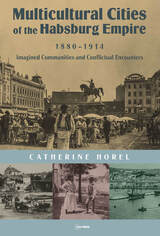 Multicultural Cities of the Habsburg Empire, 1880–1914: Imagined Communities and Conflictual Encounters
Catherine Horel
Central European University Press, 2023 Catherine Horel has undertaken a comparative analysis of the societal, ethnic, and cultural diversity in the last decades of the Habsburg Monarchy as represented in twelve cities: Arad, Bratislava, Brno, Chernivtsi, Lviv, Oradea, Rijeka, Sarajevo, Subotica, Timișoara, Trieste, and Zagreb. By purposely selecting these cities, the author aims to counter the disproportionate attention that the largest cities in the empire receive. With a focus on the aspects of everyday life faced by the city inhabitants (associations, schools, economy, and municipal politics) the book avoids any idealization of the monarchy as a paradise of peaceful multiculturalism, and also avoids exaggerating conflicts. The author claims that the world of the Habsburg cities was a dynamic space where many models coexisted and created vitality, emulation, and conflict. Modernization brought about the dissolution of old structures, but also mobility, the progress of education, the explosion of associative life, and constantly growing cultural offerings.
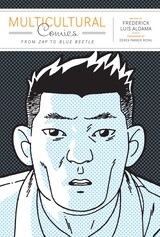 Multicultural Comics: From Zap to Blue Beetle
Edited by Frederick Luis Aldama
University of Texas Press, 2010 Multicultural Comics: From Zap to Blue Beetle is the first comprehensive look at comic books by and about race and ethnicity. The thirteen essays tease out for the general reader the nuances of how such multicultural comics skillfully combine visual and verbal elements to tell richly compelling stories that gravitate around issues of race, ethnicity, gender, and sexuality within and outside the U.S. comic book industry. Among the explorations of mainstream and independent comic books are discussions of the work of Adrian Tomine, Grant Morrison, and Jessica Abel as well as Marv Wolfman and Gene Colan's The Tomb of Dracula; Native American Anishinaabe-related comics; mixed-media forms such as Kerry James Marshall's comic-book/community performance; DJ Spooky's visual remix of classic film; the role of comics in India; and race in the early Underground Comix movement. The collection includes a "one-stop shop" for multicultural comic book resources, such as archives, websites, and scholarly books. Each of the essays shows in a systematic, clear, and precise way how multicultural comic books work in and of themselves and also how they are interconnected with a worldwide tradition of comic-book storytelling.
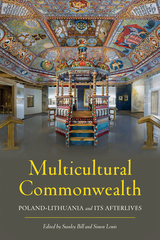 Multicultural Commonwealth: Poland-Lithuania and Its Afterlives
Stanley Bill
University of Pittsburgh Press, 2023 An Innovative Study on Historical Multiculturalism in Central and Eastern Europe
The Polish-Lithuanian Commonwealth (1569–1795) was once the largest country in Europe—a multicultural republic that was home to Belarusians, Germans, Jews, Lithuanians, Poles, Ruthenians, Tatars, Ukrainians, and other ethnic and religious groups. Although long since dissolved, the Commonwealth remains a rich resource for mythmaking in its descendent modern-day states, but also a source of contention between those with different understandings of its history. Multicultural Commonwealth brings together the expertise of world-renowned scholars in a range of disciplines to present perspectives on both the Commonwealth’s historical diversity and the memory of this diversity. With cutting-edge research on the intermeshed histories and memories of different ethnic and religious groups of the Commonwealth, this volume asks how various contemporary conceptions of multiculturalism can be applied to the region through a critical lens that also seeks to understand the past on its own terms.
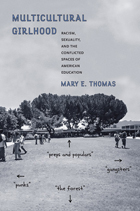 Multicultural Girlhood: Racism, Sexuality, and the Conflicted Spaces of American Education
Mary E. Thomas
Temple University Press, 2011 High school turf wars are often a teenage rite of passage, but there are extremes—as when a race riot at a Los Angeles campus in the spring of 2005 resulted in a police lockdown. In her fascinating book,Multicultural Girlhood, Mary Thomas interviewed 26 Latina, Armenian, Filipina, African-American, and Anglo girls at this high school to gauge their responses to the campus violence. They all denounced the outbreak, calling for multicultural understanding and peaceful coexistence. However, as much as the girls want everyone to just “get along,” they also exhibit strong racist beliefs and validate segregated social spaces on campus and beyond. How can teenagers and “girl power” work together to empower instead of alienate multicultural groups? In her perceptive book, Thomas foregrounds the spaces of teen girlhood and the role that space plays in girls' practices that perpetuate social difference, and she explains the ways we navigate the intellectual terrain between scholarship and school yard.
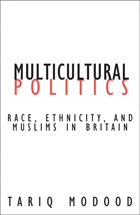 Multicultural Politics: Racism, Ethnicity, and Muslims in Britain
Tariq Modood
University of Minnesota Press, 2005 If, as W. E. B. Du Bois observed, the problem of the twentieth century was the problem of the color line, the problem of the twenty-first century may be one that reaches back to premodernity: religious identity. Even before 9/11 it was becoming evident that Muslims, not blacks, were perceived as the "other" most threatening to Western society, even in a relatively pluralist nation such as Britain. In Multcultural Politics, one of the most respected thinkers on ethnic minority experience in England describes how what began as a black-white division has been complicated by cultural racism, Islamophobia, and a challenge to secular modernity. Tariq Modood explores the tensions that have risen among advocates of multiculturalism as Muslims assert themselves to catch up with existing equality agendas while challenging some of the secularist, liberal, and feminist assumptions of multiculturalists. If an Islam-West divide is to be avoided in our time, Modood suggests, then Britain, with its relatively successful ethnic pluralism and its easygoing attitude toward religion, will provide a particularly revealing case and promising site for understanding.
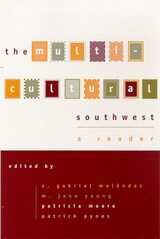 The Multicultural Southwest: A Reader
Edited by A. Gabriel Meléndez, M. Jane Young, Patricia Moore, and Patrick Pynes
University of Arizona Press, 2001 As Americans debate what it means to be a multicultural society, one need only turn for lessons to the Southwest, where distinct peoples have coexisted over centuries. Here difference has not only survived but thrived in a melting pot of races and customs. This book presents a montage of differing perspectives demonstrating that there is no single, definitive description of the Southwest. It brings together a host of writers, from early travelers and historians to contemporary commentators, who explore a region diverse in its people and ecology and show it to be not just a segment of the nation, but rather a border contact zone. The editors have assembled an interdisciplinary composite, drawing on history, sociology, anthropology, and geography. Fiction, essays, poetry, newspaper articles, and interviews with local inhabitants add a colorful dimension to the coverage. All of the contributions reveal the tremendous impact that everyday occurrences can have and show how life in the Southwest is affected by the interweaving of social, cultural, and ecological forces. Together they demonstrate the role played by personal and cultural memory in creating alternative views of environment, landscape, human social interaction, conquest, dispossession, technological change, and the survival of cultures. The Multicultural Southwest is a multifaceted work that shows the many ways in which the past continues to affect the present. It will create in readers an awareness of the phenomena that fuel human imagination and creativity as it opens their eyes to the possibilities of the future.
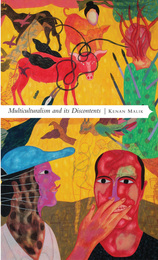 Multiculturalism and its Discontents: Rethinking Diversity after 9/11
Kenan Malik
Seagull Books, 2013 Our contemporary celebration of difference, respect for pluralism, and avowal of identity politics have come to be regarded as the hallmarks of a progressive, modern democracy. Yet despite embracing many of its values, we have at the same time become wary of multiculturalism in recent years.
In the wake of September 11, 2001 and the many terrorist attacks that have occurred since then, there has been much debate about the degree of diversity that Western nations can tolerate. In Multiculturalism and its Discontents, Kenan Malik looks closely at the role of multiculturalism within terrorism and societal discontent. He examines whether it is possible—or desirable—to try to build a cohesive society bound by common values and he delves into the increasing anxiety about the presence of the Other within our borders.
Multiculturalism and its Discontents not only explores the relationship between multiculturalism and terrorism, but it analyzes the history of the idea of multiculturalism alongside its political roots and social consequences.
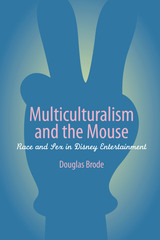 Multiculturalism and the Mouse: Race and Sex in Disney Entertainment
By Douglas Brode
University of Texas Press, 2006 In his latest iconoclastic work, Douglas Brode—the only academic author/scholar who dares to defend Disney entertainment—argues that "Uncle Walt's" output of films, television shows, theme parks, and spin-off items promoted diversity decades before such a concept gained popular currency in the 1990s. Fully understood, It's a Small World—one of the most popular attractions at the Disney theme parks—encapsulates Disney's prophetic vision of an appealingly varied world, each race respecting the uniqueness of all the others while simultaneously celebrating a common human core. In this pioneering volume, Brode makes a compelling case that Disney's consistently positive presentation of "difference"—whether it be race, gender, sexual orientation, ideology, or spirituality—provided the key paradigm for an eventual emergence of multiculturalism in our society. Using examples from dozens of films and TV programs, Brode demonstrates that Disney entertainment has consistently portrayed Native Americans, African Americans, women, gays, individual acceptance of one's sexual orientation, and alternatives to Judeo-Christian religious values in a highly positive light. Assuming a contrarian stance, Brode refutes the overwhelming body of "serious" criticism that dismisses Disney entertainment as racist and sexist. Instead, he reveals through close textual analysis how Disney introduced audiences to such politically correct principles as mainstream feminism. In so doing, Brode challenges the popular perception of Disney fare as a bland diet of programming that people around the world either uncritically deem acceptable for their children or angrily revile as reactionary pabulum for the masses. Providing a long overdue and thoroughly detailed alternative, Brode makes a highly convincing argument that with an unwavering commitment to racial diversity and sexual difference, coupled with a vast global popularity, Disney entertainment enabled those successive generations of impressionable youth who experienced it to create today's aura of multiculturalism and our politically correct value system.
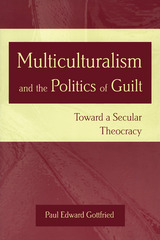 Multiculturalism and the Politics of Guilt: Toward a Secular Theocracy
Paul Edward Gottfried
University of Missouri Press, 2003 Multiculturalism and the Politics of Guilt extends Paul Gottfried’s examination of Western managerial government’s growth in the last third of the twentieth century. Linking multiculturalism to a distinctive political and religious context, the book argues that welfare-state democracy, unlike bourgeois liberalism, has rejected the once conventional distinction between government and civil society. Gottfried argues that the West’s relentless celebrations of diversity have resulted in the downgrading of the once dominant Western culture. The moral rationale of government has become the consciousness-raising of a presumed majority population. While welfare states continue to provide entitlements and fulfill the other material programs of older welfare regimes, they have ceased to make qualitative leaps in the direction of social democracy. For the new political elite, nationalization and income redistributions have become less significant than controlling the speech and thought of democratic citizens. An escalating hostility toward the bourgeois Christian past, explicit or at least implicit in the policies undertaken by the West and urged by the media, is characteristic of what Gottfried labels an emerging “therapeutic” state. For Gottfried, acceptance of an intrusive political correctness has transformed the religious consciousness of Western, particularly Protestant, society. The casting of “true” Christianity as a religion of sensitivity only toward victims has created a precondition for extensive social engineering. Gottfried examines late-twentieth-century liberal Christianity as the promoter of the politics of guilt. Metaphysical guilt has been transformed into self-abasement in relation to the “suffering just” identified with racial, cultural, and lifestyle minorities. Unlike earlier proponents of religious liberalism, the therapeutic statists oppose anything, including empirical knowledge, that impedes the expression of social and cultural guilt in an effort to raise the self-esteem of designated victims. Equally troubling to Gottfried is the growth of an American empire that is influencing European values and fashions. Europeans have begun, he says, to embrace the multicultural movement that originated with American liberal Protestantism’s emphasis on diversity as essential for democracy. He sees Europeans bringing authoritarian zeal to enforcing ideas and behavior imported from the United States. Multiculturalism and the Politics of Guilt extends the arguments of the author’s earlier After Liberalism. Whether one challenges or supports Gottfried’s conclusions, all will profit from a careful reading of this latest diagnosis of the American condition.
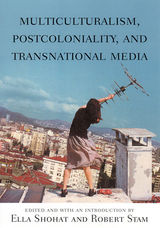 Multiculturalism, Postcoloniality, and Transnational Media
Edited by Ella Shohat and Robert Stam
Rutgers University Press, 2003 Reflecting the burgeoning academic interest in issues of nation, race, gender, sexuality, and other axes of identity, Multiculturalism, Postcoloniality, and Transnational Media brings all of these concerns under the same umbrella, contending that these issues must be discussed in relation to each other. Communities, societies, nations, and even entire continents, the book suggests, exist not autonomously but rather in a densely woven web of connectedness.
To explore this complexity, the editors have forged links between usually compartmentalized fields (especially media studies, literary theory, visual culture, and critical anthropology) and areas of inquiry-particularly postcolonial and diasporic studies and a diverse set of ethnic and area studies. This book, which links all these issues in suggestive ways, provides an indispensable guide for students and scholars in a wide variety of disciplines. Essays in this groundbreaking volume include Julianne Burton-Carvajal on ethnic identity in Lone Star; Manthia Diawara on diasporic documentary; Hamid Naficy on independent transnational film genres; Robyn Wiegman on whiteness studies; Faye Ginsburg on indigenous media; and Jennifer Gonzßles on race in cyberspace; Ana M. Lopez on modernity and Latin American cinema; and Inderpal Grewal and Caren Kaplan on Warrior Marks and multiculturalism and globalization.
Multidimensional Magnetic-Field Microsensors
Chavdar Roumenin
The Institution of Engineering and Technology, 2017 Magnetic field sensors have made significant advances over the past decade, and have found commercial importance in ubiquitous systems with navigation needs such as mobile phones - every mobile phone now contains a vectorial magnetic field sensor. This book provides a comprehensive introduction to the underlying theory of magnetic-field microsensors, their construction, and current and future applications. Written by leading experts in the development of these sensors, this book is essential reading for academics and advanced students working in sensor design and application.
Multidimensional Radar Imaging, Volume 1
Marco Martorella
The Institution of Engineering and Technology, 2020 Synthetic aperture radar and inverse synthetic aperture radar (SAR/ISAR) images have been largely used for monitoring small to large areas and more specifically for target recognition/identification. However, the technology has limitations due to the use of classical monostatic, single channel, single frequency and single polarization systems. To overcome these limitations, solutions have been proposed that show the benefit of using multiple frequencies, spatial channels, polarisations and perspective, in one word multi-dimensional radar imaging systems when dealing with non-cooperative targets.
Multidimensional Radar Imaging, Volume 2
Marco Martorella
The Institution of Engineering and Technology, 2024 Increasing the performance of radar imaging systems will directly improve the effectiveness of automatic target recognition (ATR) systems. New ideas and solutions have been proposed in the recent NATO SET-250 Research Task Group (RTG) on multi-dimensional radar imaging, which initiated its activities in March 2017 and concluded them in October 2021. The goal of the SET-250 was to further develop systems and algorithms by using radar systems with extended dimensionality, such as multi-frequency, multi-polarisation and multi-view/multi-pass.
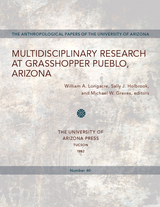 Multidisciplinary Research at Grasshopper Pueblo, Arizona
Edited by William A. Longacre, Sally J. Holbrook, and Michael W. Graves
University of Arizona Press, 1982 “For the past twenty years the University of Arizona’s archaeological field school has been conducting research focused on Grasshopper Pueblo, a large, fourteenth-century Western Anasazi site, located below the Mogollon Rim, on the Fort Apache Reservation, in Arizona. . . . Research questions pursued at Grasshopper involve explicating the founding, growth, and abandonment of the site within the context of three broad areas of causality. These are environmental and climactic change; regional and interregional economics, especially trade; and subsistence change, including agricultural intensification. The papers in this volume . . . are presented as specialized contributions to this work.”—Journal of Anthropological Research
Contributors:
Larry D. Agenbroad
Eric J. Arnould
Walter H. Birkby
Vorsila L. Bohrer
Jeffrey S. Dean
Michael W. Graves
Sally J. Holbrook
Gerald K. Kelso
William A. Longacre
Charmion R. McKusick
J. Jefferson Reid
John W. Olsen
Stanley J. Olsen
William Reynolds
William J. Robinson
Izumi Shimada
Stephanie M. Whittlesey
David R. Wilcox
Multiethnic Japan
John Lie
Harvard University Press, 2004 Multiethnic Japan challenges the received view of Japanese society as ethnically homogeneous. Employing a wide array of arguments and evidence--historical and comparative, interviews and observations, high literature and popular culture--John Lie recasts modern Japan as a thoroughly multiethnic society.
Lie casts light on a wide range of minority groups in modern Japanese society, including the Ainu, Burakumin (descendants of premodern outcasts), Chinese, Koreans, and Okinawans. In so doing, he depicts the trajectory of modern Japanese identity.
Surprisingly, Lie argues that the belief in a monoethnic Japan is a post–World War II phenomenon, and he explores the formation of the monoethnic ideology. He also makes a general argument about the nature of national identity, delving into the mechanisms of social classification, signification, and identification.
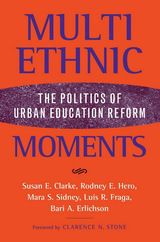 Multiethnic Moments: The Politics of Urban Education Reform
Susan E. Clarke, Rodney E. Hero, Mara S. Sidney, Luis Fraga and Bari Anhalt Erlichson, foreword by Clarence N. Stone
Temple University Press, 2006 When courts lifted their school desegregation orders in the 1990s—declaring that black and white students were now "integrated" in America's public schools—it seemed that a window of opportunity would open for Latinos, Asians, and people of other races and ethnicities to influence school reform efforts. However, in most large cities the "multiethnic moment" passed, without leading to greater responsiveness to burgeoning new constituencies. Multiethnic Moments examines school systems in four major U.S. cities—Boston, Denver, Los Angeles, and San Francisco—to uncover the factors that worked for and against ethnically-representative school change. More than a case study, this book is a concentrated effort to come to grips with the multiethnic city as a distinctive setting. It utilizes the politics of education reform to provide theoretically-grounded, empirical scholarship about the broader contemporary politics of race and ethnicity—emphasizing the intersection of interests, ideas, and institutions with the differing political legacies of each of the cities under consideration.
 Multilateral Institutions: A Critical Introduction
Morten Boas and Desmond McNeill
Pluto Press, 2003 In recent years, a great deal of public attention has been focussed on multilateral institutions such as the World Bank, IMF and WTO. This book offers students, practitioners and activists a critical guide to these and other major institutions - the Regional Development Banks and UNDP - that make up the multilateral development system. It analyses how they operate with respect to financing and lending, the various roles that they play, and related changes in their policy concerns - such as structural adjustment, sustainable development, and governance.
The emphasis is on politics within and also between multilateral institutions, analysing the relations – both competitive and collaborative – between, for example, the World Bank and UNDP. NGOs are also shown to be important actors, and the role they have played in recent years is critically assessed. The book concludes with some emerging trends: the ‘privatisation’ of the system, regionalisation, and ‘the politics of protest’.
Bøås and McNeill do not simply take the policies of multilateral institutions at face value, but ask how and why these policies came into existence. They seek to promote critical, but informed, engagement both with the member states of multilateral institutions and the institutions themselves.
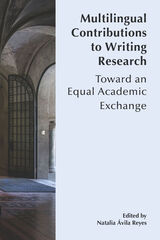 Multilingual Contributions to Writing Research: Towards an Equal Academic Exchange
edited by Natalia Ávila Reyes
University Press of Colorado, 2022 This edited collection offers chapters based on presentations at the Second Latin American Association of Writing Studies in Higher Education and Professional Contexts International Congress (II ALES) held in Santiago, Chile, in 2018. Together, the contributors to the collection—drawn from nine countries and writing in three languages—highlight the many perspectives, resources, and traditions that enrich and expand international conversations about writing, writing instruction, and writing research. The multiple locations from which the chapters in this collection emerge contribute significantly to the situated findings and concerns they address, with the authors of each chapter considering the social, lingual, and institutional contexts shaping their work. Drawing on both robust traditions and cutting-edge research, this collection makes a distinctive contribution to discussions of writing in and beyond Latin America. This book is also available as an open access ebook through the WAC Clearinghouse.
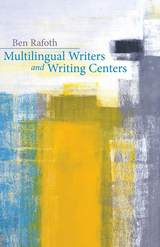 Multilingual Writers and Writing Centers
Ben Rafoth
Utah State University Press, 2015 Multilingual writers—often graduate students with more content knowledge and broader cultural experience than a monolingual tuto—unbalance the typical tutor/client relationship and pose a unique challenge for the writing center. Multilingual Writers and Writing Centers explores how directors and tutors can better prepare for the growing number of one-to-one conferences with these multilingual writers they will increasingly encounter in the future. This much-needed addition of second language acquisition (SLA) research and teaching to the literature of writing center pedagogy draws from SLA literature; a body of interviews Rafoth conducted with writing center directors, students, and tutors, and his own decades of experience. Well-grounded in daily writing center practice, the author addresses which concepts and practices directors can borrow from the field of SLA to help tutors respond to the needs of multilingual writers, what directors need to know about these concepts and practices, and how tutoring might change in response to changes in student populations.
Multilingual Writers and Writing Centers is a call to invigorate the preparation of tutors and directors for the negotiation of the complexities of multilingual and multicultural communication.
 Multilingual Writing in Entanglement: Becoming With Others Through Chronotopic Figuring and Unpredictable Encounters
Xiqiao Wang
Utah State University Press, 2025 Multilingual Writing in Entanglement offers deep, behind-the-scenes insight into multilingual writing processes through ethnographically constructed case studies of two Chinese international students navigating first-year writing assignments. Drawing on fungi studies to develop ecology-informed metaphors, Xiqiao Wang traces how these students’ writing unfolds alongside multilingual living, revealing the thickets of relationships with both human participants (peers, teachers, writing consultants) and nonhuman elements (trees, rivers, digital texts, writing technologies) that create opportunities for negotiating across differences. This longitudinal qualitative study follows Morgan and Leo through their undergraduate careers, collecting rich ethnographic data across private, academic, and digital spaces. The resulting theoretical framework conceptualizes multilingual writing as simultaneously strategic, agentive, creative, diffused, contingent, and messy—a phenomenon shaped by dynamic interplay between ephemeral encounters and established practices. Employing chronotopic figuring as a methodological tool, Wang illuminates aspects of multilingual writing often elided in research: fleeting encounters that energize composition, reciprocal relationships that distribute writing labor, unexpected detours that redirect the writing process, and the layering of writing and identity practices across multiple historical trajectories. This approach moves beyond examining writing in isolated moments to trace how meaning emerges across languages, modes, and spacetimes. Multilingual Writing in Entanglement offers crucial insights into how international students strategically and improvisationally reconfigure their semiotic and rhetorical repertoires to write multilingual lives into meaning. This work is influential for scholars and educators in composition, literacy studies, multilingual education, ESL, and linguistics.
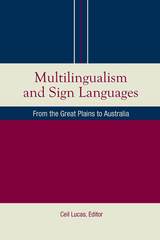 Multilingualism and Sign Languages: From the Great Plains to Australia
Ceil Lucas
Gallaudet University Press, 2006 The 12th Volume in the Sociolinguistics in Deaf Communities Series
The latest entry in the Sociolinguistics in Deaf Communities series continues to mine the rich resources found in signing communities throughout the world. Divided into four parts, this collection features 16 internationally renowned linguistics experts whose absorbing studies reflect an astonishing range of linguistic diversity.
The sole essay in Part One: Multilingualism describes historic and contemporary uses of North American Indian Sign Language. Part Two: Language Contact examines language-contact phenomena between Auslan/English interpreters and Deaf people in Australia, and the features of bimodal bilingualism in hearing, Italian, native signers. Part Three: Variation reports the results of a study on location variation in Australian Sign Language.
Part Four: Discourse Analysis begins with an analysis of how deaf parents and their hearing toddlers establish and maintain sight triangles when conducting signed conversations. The ensuing chapter explores the use of evaluation within an informal narrative in Langue des Signes Québécoise. The final chapter explicates how a signer depersonalizes the concept of “self” in an American Sign Language narrative through the use of signs for “he” and “I.”
Multilingualism, Nationhood, and Cultural Identity: Northern Europe, 16th-19th Centuries
Edited by Willem Frijhoff, Marie-Christine Kok Escalle, and Karène Sanchez-Summerer
Amsterdam University Press, 2017 Before the modern nation-state became a stable, widespread phenomenon throughout northern Europe, multilingualism-the use of multiple languages in one geographical area-was common throughout the region. This book brings together historians and linguists, who apply their respective analytic tools to offer an interdisciplinary interpretation of the functions of multilingualism in identity-building in the period, and, from that, draw valuable lessons for understanding today's cosmopolitan societies.
The Multilingualism of Constantijn Huygens (1596-1687)
Christopher Joby
Amsterdam University Press, 2015 Dutch, French, Latin, Greek, Italian, English, Spanish, and German: those are the eight languages in which Dutch Golden Age poet Constantijn Huygens (1596—1687) wrote his poetry and correspondence. He also knew a bit of Hebrew and Portuguese. Examining a wide range of Huygens’s writings“including personal letters, state correspondence, and poetry“Christopher Joby explores how Huygens tested the boundaries of language with his virtuosity as a polyglot. From Huygens’s multilingual code switching to his writings on architecture, music, and natural science, this comprehensive account is a must-read for anyone interested in this Dutch statesman and man of letters.
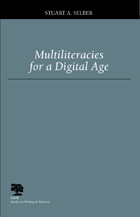 Multiliteracies for a Digital Age
Stuart A. Selber
Southern Illinois University Press, 2004 Just as the majority of books about computer literacy deal more with technological issues than with literacy issues, most computer literacy programs overemphasize technical skills and fail to adequately prepare students for the writing and communications tasks in a technology-driven era. Multiliteracies for a Digital Age serves as a guide for composition teachers to develop effective, full-scale computer literacy programs that are also professionally responsible by emphasizing different kinds of literacies and proposing methods for helping students move among them in strategic ways. Defining computer literacy as a domain of writing and communication, Stuart A. Selber addresses the questions that few other computer literacy texts consider: What should a computer literate student be able to do? What is required of literacy teachers to educate such a student? How can functional computer literacy fit within the values of teaching writing and communication as a profession? Reimagining functional literacy in ways that speak to teachers of writing and communication, he builds a framework for computer literacy instruction that blends functional, critical, and rhetorical concerns in the interest of social action and change. Multiliteracies for a Digital Age reviews the extensive literature on computer literacy and critiques it from a humanistic perspective. This approach, which will remain useful as new versions of computer hardware and software inevitably replace old versions, helps to usher students into an understanding of the biases, belief systems, and politics inherent in technological contexts. Selber redefines rhetoric at the nexus of technology and literacy and argues that students should be prepared as authors of twenty-first-century texts that defy the established purview of English departments. The result is a rich portrait of the ideal multiliterate student in a digital age and a social approach to computer literacy envisioned with the requirements for systemic change in mind.
Multimedia Histories: From the Magic Lantern to the Internet
James Lyons and John Plunkett
University of Exeter Press, 2007
Multimedia Histories: From the Magic Lantern to the Internet is the first book to explore in detail the vital connections between today’s digital culture and an absorbing history of screen entertainments and technologies. Its range of coverage moves from the magic lantern, the stereoscope and early film to the DVD and the internet.
By reaching back into the innovative media practices of the nineteenth century, Multimedia Histories outlines many of the revealing continuities between nineteenth, twentieth, and twenty-first century multimedia culture. Comprising some of the most important new work on multimedia culture and history by key writers in this growing field, Multimedia Histories will be an indispensable new sourcebook for the discipline. It will be an important intervention in rethinking the boundaries of Anglo-American film and media history.
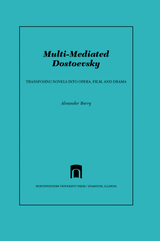 Multi-Mediated Dostoevsky: Transposing Novels into Opera, Film, and Drama
Alexander Burry
Northwestern University Press, 2011 Since their publication, the works of Dostoevsky have provided rich fodder for adaptations to opera, film, and drama. While Dostoevsky gave his blessing to the idea of adapting his work to other forms, he believed that "each art form corresponds to a series of poetic thoughts, so that one idea cannot be expressed in another non-corresponding form." In Multi-Mediated Dostoevsky, Alexander Burry argues that twentieth-century adaptations (which he calls "transpositions") of four of Dostoevsky’s works—Sergei Prokofiev’s opera The Gambler, Leos Janacek’s opera From the Dead House, Akira Kurosawa’s film The Idiot, and Adrzej Wajda’s drama The Devils—follow Dostoevsky’s precept by bringing to light underdeveloped or unappreciated aspects of Dostoevsky’s texts rather than by slavishly attempting to recreate their sources. Burry’s interdisciplinary approach gives his study broad appeal to scholars as well as to students of Russian, comparative literature, music, film, drama, and cultural studies.
|
|